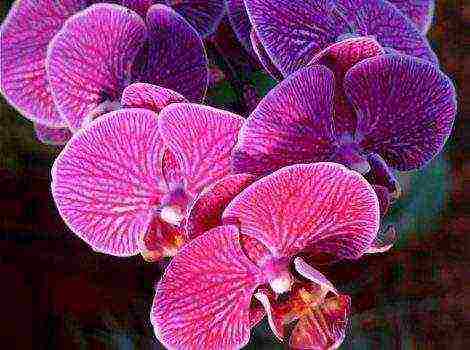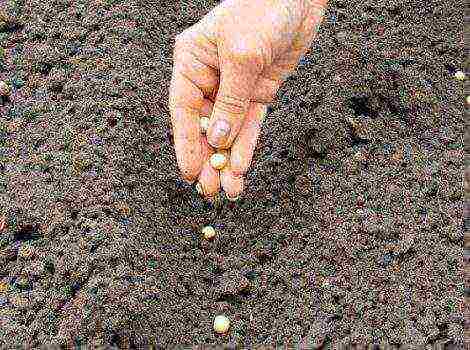Protected soil is called a special cultivation room equipped to create an artificial favorable microclimate or improve the natural climate for growing vegetables and other crops. These include winter greenhouses, glass and film coated spring greenhouses, temporary film shelters (film frames) and greenhouses. Spring greenhouses and temporary film coatings are the most widespread in household and garden plots.
The term of use of the greenhouse in the season is from April to September. The greenhouse is oriented along the ridge from north to south.
For a new greenhouse, a special soil is prepared in advance for cucumbers from equal parts of manure or humus, turf and peat. Acidity should be within pH 6.5-7... Before planting cucumbers, organic fertilizers are introduced into the soil - manure or compost (2-3 buckets per square meter), evenly scattering them over the surface, and mineral fertilizers: simple superphosphate 80 g or double 40 g, urea 30 g, potassium sulfate or potassium salt 30 g. Close up the fertilizer under the shovel to the full depth of the humus layer.
Before planting seedlings, the soil is leveled and well moistened. Then the landing sites are marked. They are planted with double-row ribbons: between ribbons 80-90 cm, between rows in a ribbon 50-60 cm, between plants in rows 40 cm. Depending on the capacity of the plant per sq. 3-4 plants are placed per meter, female-type bee-pollinated hybrids, forming a large number of female flowers and a small number of male ones, cannot be grown in clean crops, it is necessary to plant pollinating varieties to them up to 10%.
The main factor contributing to high yields of cucumber in greenhouses is the high quality of seedlings. The harvest and the timing of its receipt depend on the quality of the seedlings. Seedlings should be healthy, stocky, well-developed roots and dark green leaves. Such seedlings can be grown when the necessary conditions are created for the plants. It is best to grow seedlings in greenhouses, greenhouses and on heated soil with film coatings; it is more difficult, but quite possible, to create the necessary conditions for it in the room. Seedlings must be grown in pots - peat or homemade (paper, plastic wrap, milk bags, etc.). Pots for seedlings of cucumbers are used with a diameter of 12-15 cm. The density of the arrangement of potted seedlings is 25-30 plants per 1 sq. m of illuminated area.
When growing seedlings, the following temperature regime must be observed: before the emergence of shoots - 26-28 ° C, with the appearance of shoots, the temperature is reduced in the daytime to 20-22 ° C, at night - to 16-17 ° C. After 4-6 days, it is increased again in sunny weather to 24-26 ° С, in cloudy - 20-22 ° С. The temperature is maintained at 17-18 ° C at night. The water temperature for irrigating seedlings should be at least 22-24 ° C. When growing seedlings in the room, the temperature should be maintained at 20-22 ° C. Irrigation water should be at the same temperature.
With the emergence of seedlings, boxes with cups (pots) are placed in the brightest place, and it is desirable to lower the temperature for 3-5 days to 15-17 ° C during the day and to 12 ° C at night. In the future, it is again increased during the day to 20-22 ° C and at night to 16 ° C. Twenty-five-day-old seedlings are planted in a permanent place in a greenhouse and under temporary film shelters. When planting cucumbers in the soil, remove the film, paper, etc. from the pot and bury the plant in the soil so that the hypocotyl knee is open.
In the greenhouse, the cucumber plants (7-10 days after planting) are tied up. In the future, they are fed and formed taking into account the characteristics of the variety.
Watering is carried out during the day with warm water (25-30 ° C), since from cold water or from low air temperatures, cucumber plants get sick with root rot, shed the first female flowers, and form ugly fruits. Cucumber plants are very heat demanding. Seeds begin to germinate only at 13-15 ° C (the optimum temperature is 25-30 ° C), and female flowers form at a daytime temperature of 25-32 ° C and a night temperature of 18-20 ° C. Sudden changes in temperature should not be allowed, as they lead to the weakening of plants and the appearance of diseases. The relative humidity in the greenhouse is maintained: before fruiting - about 80%, during fruiting - 90%.
Tomato plants are even more light-requiring than cucumber plants. Seedlings are ready in 50-55 days. By this time, it has 8-9 leaves and a formed flower raceme. An important point in the agrotechnology of seedlings is their timely placement over long distances as they grow. Seedling yield - 20-25 pcs. per m2.
The optimum temperature for germination of seeds is 24-25 ° C, at a temperature of 10 ° C they do not germinate. After the cotyledons and the first two true leaves appear in plants, the temperature is lowered to 18-20 ° C during the day and 14-16 ° C at night. This temperature regime contributes to the good development of the first inflorescence. When the first buds appear on the plant, the temperature is reduced to 17-18 ° C during the day, and to 16 ° C at night. The optimum air and soil temperature for tomato is largely determined by illumination: in sunny weather in summer 22-25 ° С, on a cloudy day - 20-22 ° С, at night - 16-18 ° С. At a temperature of 30-32 ° C and above, a significant decrease in plant growth is observed. The pollen in such conditions becomes sterile, the flowers fall off without setting fruit. Temperatures below 14 ° C are also critical for fertilization. At a temperature of 10 ° C, plant growth stops. The optimum soil temperature is 20-25 ° C. The optimal time for planting seedlings in unheated greenhouses in the middle lane is May 5-10. Seedlings are planted at a temperature of the upper soil layer above 14-16 ° C. 2-3 days after planting, the plants are tied up. The planting scheme is tape, in two rows (80 + 50) x 20 + 35 cm when growing determinant varieties and (90 + 60) x 35 cm - semi-determinant and indeterminate varieties. For better illumination of the plants, the beds are located from north to south. Indeterminate varieties usually form in one stem.
Determinant varieties in film greenhouses are also formed into one stem, less often - into two.
When these varieties are grown in one stem, a small continuation shoot is often left under the first inflorescence.
After the formation of one or two inflorescences and several leaves, pinch it. With long-term cultivation of determinant tomato varieties in one stem (more than 4-5 months), it must be remembered that these varieties, due to their biological characteristics, limit the growth of the inflorescence. And if by this moment all the stepsons are removed, the plant will simply stop growing. To prevent this from happening, such varieties always leave a reserve stepchild shoot, located under one of the uppermost inflorescences, which will become the continuation shoot.
When pinching (removing side shoots), the shoots are not broken out, but cut off, leaving small "stumps" (0.5 cm). Determinant tomato varieties are somewhat more difficult to form than semi-determinant and indeterminate varieties, in which there is practically no limitation of the growth of the stem to the inflorescence and there is no need for a reserve shoot. But determinant varieties and hybrids are more early maturing and use the volume of the greenhouse better. For the same trellis height (2.2 m) in heated film greenhouses, they form 12-16 inflorescences, which is one and a half times more than in indeterminate varieties. 35-45 days before the end of the tomato culture in the greenhouse, pinch the main stem. 1-2 leaves are left on the last inflorescence, which ensures better fruit growth. Continue to remove all stepchildren from the axils of the leaves, especially in the upper part of the plant.
When grown in a greenhouse, tomato plants are rarely, but plentifully, watered with water at a temperature of at least 20 ° C. The moisture content of the soil before fruit set is kept at a fairly low level. After the appearance of fruits on the first 2-3 inflorescences, watering should be carried out more often.
In 30-40 days after planting the seedlings, periodically on sunny days in the morning, the lower leaves are removed from the plants. By the time the fruit ripens, there should be no leaves below it on the stem on the first inflorescence. The leaves are removed in the future. This improves air exchange in the lower part of the plant and accelerates fruit ripening.
During the growing season, plants need to be fed (every 2-3 weeks). Before fruit setting on the first inflorescences, nitrogen fertilizers should not be included in top dressing, especially on nitrogen-rich soils. An excess of this element in the soil manifests itself in a strong thickening of the stem and curling of the upper leaves. In this feeding, plants are given 20-25 g of superphosphate and 25-30 g of potassium salt per 10 liters of water. Subsequently, with the growth of fruits, nitrogen fertilizers are also added - 25-30 g of ammonium nitrate, 40 g of superphosphate and 30 g of potassium salt per 10 liters of water. One bucket of solution is consumed for 4-5 sq. m.
To improve fruit setting, the flowering inflorescences are shaken or tapped lightly. At high air humidity, pollen becomes loose and poorly spills out of the pollen sacs. Therefore, in the morning, the greenhouse is intensively ventilated, the air is dried and only after that the inflorescences begin to shake.
(For home gardens)
Plants of the tropics in the climate of the USSR require them to be kept in greenhouses. Plants of upland tropical and subtropical countries with a warm temperate climate are cultivated in temperate greenhouses (plants of the upland tropics) and in cooler greenhouses (plants of upland subtropics).
Among greenhouse plants, there is a large selection for indoor landscaping. The choice of greenhouse, that is, tropical plants for the same purposes is limited, since few tropical plants can put up with the conditions of keeping them in ordinary residential and public buildings.
Many of the greenhouse and especially greenhouse plants can be used for temporary maintenance in indoor landscaping during their flowering period. In summer, greenhouse evergreens need to be kept outdoors, which strengthens and promotes their further development.
Floral plants in greenhouses and greenhouses, as well as floral plants in open ground, are divided into three sections: flowering plants, decorative deciduous plants and plants that are not included in the first two sections (climbing, hanging and with beautiful fruits).
In the section of flowering plants, that is, those cultivated mainly for flowers, there are four groups: trees, shrubs and semi-shrubs; herbaceous plants; bulbous plants; epiphytes.
TREES, SHRUBS AND SEMI-SHRUBS
Flowering trees, shrubs and shrubs are one of the largest and most important departments of ornamental floriculture. The main representatives of this department are discussed below in alphabetical order. But all these plants can at the same time be divided into groups, within which the plants will be related in their origin, similar in methods of culture, etc.
Of these groups of plants, the following can be noted: evergreen trees, shrubs and shrubs and trees, shrubs and shrubs with falling leaves.
Evergreens include:
heather plants, the main representatives of which are azalea, camellia and rhododendron. Heather plants are kept in the shade outdoors in summer and in cool rooms in winter. Heather plants have been preparing flower buds since autumn. Heather plants do not tolerate overdrying of an earthen coma and watering with lime water.
Southern European plants, such as: iburnu mtinus, myrtle, eugenia, oleander, etc. These plants are kept outdoors in summer and in bright rooms in winter.
New Dutch plants: acacia, callistemon, libonia, melaleuca, cytisus, etc. The latter plants contain the same as South European plants, but in culture, New Dutch plants are more demanding.
Gardenia, hibiscus, clerodendron, etc. plants require a lot of heat and moisture. They are kept in warm rooms and are often sprayed during growth. They bloom in the summer-winter period.
Plants with falling leaves include: hydrangea, roses, fuchsia, etc. In the summer, these plants are kept outdoors. In winter, they lose their leaves. They bloom in the spring-summer and autumn periods.
The most important flowering trees, shrubs and shrubs include the following plants:
Abutilene. Abutilon. Sem. Malvovs. Greenhouse tree with evergreen maple-shaped, green and white-variegated leaves (Fig. 143). Abundant, variegated, bell-shaped, drooping flowers. There are large-flowered hybrids. Propagated by cuttings and seeds. Blooms five months after sowing. Unpretentious plants. Best views: A. Darwini, A. Thomsoni.
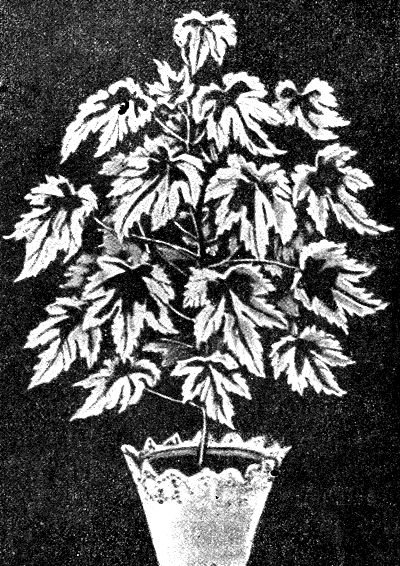
Rice. 143. Abutilene variegated
Of the hybrids known: Boule de Neige with white flowers and Perle d'or with golden flowers, etc. In summer they are used to decorate balconies.
Adenocarpus (Adenocarpus). Sem. Motylkovs. Sprawling, profusely flowering shrub with fragrant yellow flowers. Blossoming in March-April.
Propagation by seeds and cuttings. The soil is nutritious and permeable. After flowering, transplant and shorten branches. Avoid large pots. In summer, keep on the balcony.
Azalea (Azalea). Sem. Heathers (Fig. 144). Well-known beautifully flowering shrubs. One group of evergreen azaleas (A. indica) kept in greenhouses does not lose leaves, another group that sheds leaves (A. pontica) hibernates in the ground with proper protection.
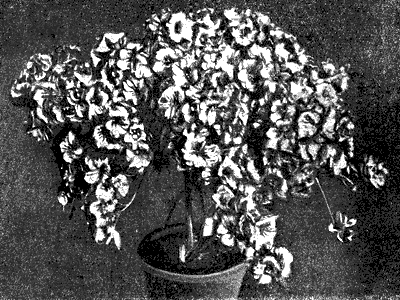
Rice. 144. Azalea
There are a large number of beautiful varieties as a result of crossing azaleas with each other. Indian azaleas are best cultivated in low gable greenhouses, where they must be kept from October to May, and then taken out into the air.
Overdrying azaleas leads to the loss of not only buds, but also leaves. Watering can only be done with soft water. In addition to abundant watering, azaleas must be sprayed in summer. Propagated by seeds, cuttings in summer (August) or winter (January-February).
Grafting is used to accelerate flowering, more abundant flowering and to form stronger growth in weaker varieties. Young plants are grafted by copulation, and mature plants are split into vigorously growing wilds (A. phoenicea) and rhododendrons from February to August. Rooms with grafted plants are shaded. With a pinch, the azaleas are given a pyramidal, spherical and umbrella shape. In the spring, pruning or haircutting is carried out and transplanted into more spacious, wide, but not high pots. In the summer (in June), the pots are dug into the ground.
Care consists in spraying, watering, fertilizing and forming the crown. The shoots that appear in A. indica near the buds are plucked out, otherwise the buds near such shoots may freeze. In winter, plants should be kept at 2-4 ° C. For flowering, early varieties with sufficiently developed buds are attached at a temperature of 10-15 ° C. A. pontica, after it sheds leaves, is stored in walls or basements.
Azaleas require peat land with leafy and some admixture of sand. Old specimens of azaleas are rejuvenated by short pruning, followed by pinning and planting in the ground for the summer. Azaleas, like other heathers (camellia, rhododendron), bloom in the second half of winter and early spring. These three plants are harvested buds in the fall.
Azaleas require a warm climate. The Moscow Green Building Trust leads the culture of azaleas, rhododendrons and camellias to Batumi, from where specimens aged from 3 to 5 years come to Moscow. In the conditions of the central zone of the Union, only the content of azaleas and their addition for flowering are possible. Of the Indian varieties, A. perle - white - is the most suitable for early addition in December. Varieties A.pontica, even before the leaves bloom, are completely covered with beautiful flowers.
Akalifa. Acalypha. Sem. Euphorbiacetes. Tropical ornamental evergreen shrubs with variegated leaves. Minor flowers in ears. Recently, beautifully flowering hybrids have been obtained that have retained the variegation of their leaves. Reproduction in spring by cuttings. The land is given in a mixture of coniferous, leafy and fibrous sod.
Acacia (Fig. 145). Sem. Mothykovs. A greenhouse shrub with delicate green foliage, folded overnight, or with phyllodia (leafy petioles). Flowers are yellow, rarely white, with a pleasant smell, collected in spherical or elongated heads or ears.
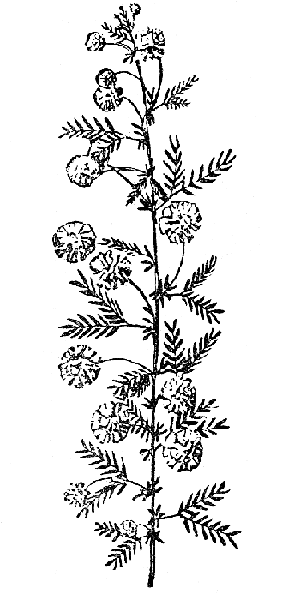
Rice. 145. Spotted Acacia
Of the acacias with feathery leaves, the best known are A. dealbata, A. Drummondi, A. laphantha, pulchella; with phylodia - A. armata, A. cuneata, A. floribunda, A. lineata, A. longifolia, A. paradoxa.
For the summer, the acacias from the greenhouse are exposed to the air. Propagated mainly by seeds. Acacia with feathery leaves is given a heavy earth - clay-turf mixed with leaf; acacias with phyllody - sandy rough heather land with an admixture of clay-turf. Acacia flowers bloom in late winter or spring. After flowering, branches are transplanted and shortened in order to induce young growth. Every March in Moscow in shops and kiosks of the Green Building Trust and hawkers on the streets a huge amount of A. dealbata coming from the south is sold in cut branches. It is incorrectly called mimosa.
Aphelandra. Sem. Akantov. Graceful greenhouse shrubs with ornamental leaves and two-lipped flowers in terminal quadrangular ears. Propagation by seeds and cuttings. The land is a mixture of clay-turf, peat and sand. The best winter blooming species are A. aurantiaca, A. hitens, A. chrysops, and A. tetragona.
Boronia (Fig. 146). Sem. Diasmovs. Greenhouse evergreen shrub with small leaves. Blooms for a long time in spring with strongly fragrant pink-red flowers. Propagated by seeds and cuttings. Cuttings with soft wood are cut in spring from young plants aged (20-30 days) kept in a warm greenhouse.
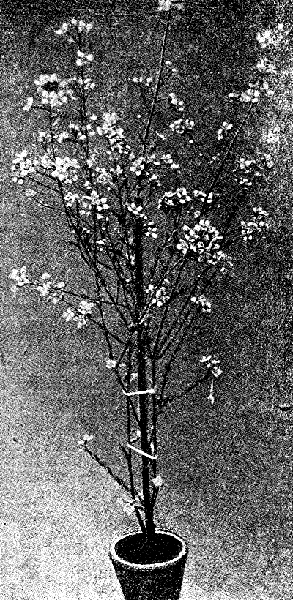
Rice. 146. Boronia
Land for planting is taken in a mixture of leaf, heather, turf with coarse sand. Transplant in the spring after flowering. Watering is moderate. The earthen ball should be neither dry nor damp.
In the summer they are kept in the air - in the shade, in pots, lowered by half in a ridge with soil well-permeable to water. On sunny days, spraying of plants and paths is necessary. To obtain bushiness, the plants are shortened after flowering. Wintering at 5-7 ° C in light greenhouses. The best kind of V. elatior with red flowers.
Bouvardia. Sem. Marenovykh. Valuable greenhouse, late flowering plants, strongly fragrant. Flowers with a long tube and a four-legged star-shaped limb are collected in false umbrellas. Bouvardia with white flowers: simple - alda adorata, jasminiflora, Pride of Brooklyn; terry - alba plena. With red flowers: President Cleveland chill; terry - Victor Lemoine, Lothringer Bluf.
Flowering begins in autumn at 10-12 ° C and lasts until winter.
Propagated by cuttings. In February, the plants are placed in a warm compartment of the greenhouse so that the bouvardia starts growing. Cuttings are obtained from still not woody shoots. Rooting of cuttings is done in a greenhouse exploration box or in pots on a greenhouse. From the rooting box, they are planted in pots. During the summer, bushy plants are obtained by pinching 1-2 times. The land is given to the plants as an ordinary greenhouse with an admixture of sod and sand. A short cut of 2-4 eyes is required. Hybrids with yellow flowers are easier and easier to grow and bloom longer. Bouvardias are good for cutting.
Bougainvillea. Sem. Nightflowers. Beautiful climbing greenhouse shrubs with a lot of purple-red small flowers. Bloom from spring to summer. Reproduction in spring by cuttings with matured wood at a temperature of 25 ° C.Especially good adult specimens in tubs.
Heather (Erica) (fig. 147). Sem. Vereskovykh. Greenhouse, graceful, beautifully flowering, evergreen bushes with fine, tough greens. Some varieties of heather have large flowers of very white, red, bright purple and other colors.
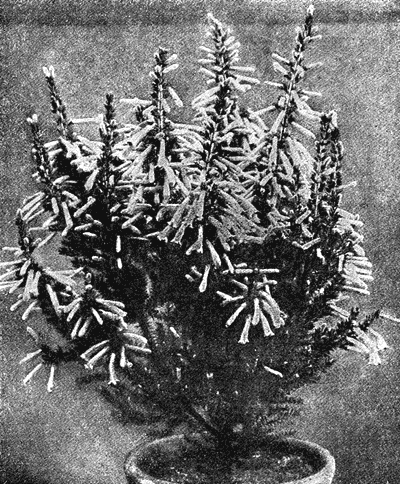
Rice. 147. Heather (Erica)
Heather needs cool, clean air and a bright spot. Propagation by sowing and cuttings. Heather is kept in pots with heather earth and good drainage. They fight mold with sulfur; the sulfur, however, must not get on the ground of the pot.
Heathers are used, among other things, to decorate tables in indoor landscaping. Heather lends itself to molding, which begins at a young age.
Heather, like azalea. cultivated in the south in the ground. The most common and least whimsical form is Erica gracilis (E. gracilis).
E. curviflora is very beautiful.
Villaresia Sem. Holly. An unpretentious houseplant with leathery dark green leaves on drooping branches. Small white flowers. Propagation by seeds and cuttings. The best view is V. grandiflora.
Gabrotamnus (Habrolhamnus). Sem. Solanovykh. Greenhouse graceful shrubs with swollen tubular, yellow and red flowers in drooping dense racemes. Propagated by cuttings.
Gardenia (Gardenia). Sem. Marenovykh. A greenhouse shrub of outstanding beauty with evergreen leathery, shiny leaves and dazzling white, very fragrant flowers reminiscent of tuberose. Blooms from April-May to September-October.
Propagated by cuttings. The land is given in a mixture of turf with humus, peat and river sand. Gardenia suffers from thrips and hairy aphids.
The best species: G. florida (multicolor), G. radicans, G. citriodora (with an orange scent).
Hydrangea (Hydrangea Hortensis). Sem. Stonefragments. Favorite greenhouse shrub with flowers in large umbrellas or, as gardeners say, in caps of large, showy inflorescences of pink, white, blue, blue and red colors. A potted plant produces 3-6 flower caps, each up to 30 cm in diameter. Bloom from spring to autumn.
Hybridizers in France and Germany have received the latest varieties of hydrangeas, which are prepared in one year instead of two years.
The most famous varieties of hydrangeas: with white flowers - Avalanche, M. E. Manilliere, La perle and M-lle Renel Gaillard; with pink - La Lorraine, L. Eclaireur Radiant, Reingold, Helge, Wiking; with red - Elmar. Nierles, Sachsen.
A double variety is known - Domotoi - one of the excellent plants for indoor gardening. In view of its unpretentiousness and endurance, even a hydrangea planted in the ground blooms in the open air for 1-2 months.
In addition to this greenhouse form of hydrangeas, there is a beautiful wintering species of H. paniculata that blooms profusely by autumn, which, however, requires some shelter for the winter, for example, hilling with earth.
Propagated mainly by cuttings from weaker shoots or lower offshoots from the neck. Cuttings are made from January to April. From cuttings in May, single-stemmed plants suitable for winter flowering are obtained by autumn. Cuttings should be cut with a sharp and clean knife with 2-4 knots, depending on the availability of prospecting material. Cuttings with small leaves are accepted more successfully. Cutting cuttings should be done just before planting them. Rooting is carried out in the cutting box of an exploration greenhouse or in cutting boxes installed on racks at a temperature of about 14-15 ° C.
Care consists in maintaining the soil in a moderately moist state, spraying 2-3 times, shading in the sun and cleaning. Before the formation of an influx (callus), the plants must be in the stale air. Rooted cuttings (which usually takes 15-20 days), accustomed to fresh air, are planted singly in 6-7-centimeter (1.5 vert.) Pots. Until warm weather sets in, they are kept in greenhouses under the frames. Frames are removable on warm days. If necessary, provide transshipment. Care - watering, cleaning, airing and forming a bush.
In June or even earlier - in May, depending on the weather, the plants are set in the open air beds. Care - watering, shelf and loosening. For full and timely ripening, watering should be reduced in early September, sometimes even earlier - in August. It is necessary to keep in mind the tendency of hydrangeas to fattening, why excessive nitrogenous fertilizers should be avoided. If the cuttings were carried out in January and already in May the plants were taken out into the open air, then in August the plants with buds are brought into the greenhouse, where in a month (in September) they will already be in bloom.
From the ground, plants intended for winter flowering are removed to greenhouses for better ripening, and only sluggish plants are watered.
By early harvesting plants directly into the basement, a large percentage of barren flowers are obtained. The basement is removed in October. Plants that are not used for winter flowering in spring are transferred from basements to cold greenhouses, and in July they are buried in pots in outdoor beds, where they bloom in July-August.
Plants are usually grown in 1-2-3 umbrellas by growing them. Within 5-6 years, you can achieve tub hydrangeas with several dozen umbrellas. It is necessary to take large pots with an increase in the number of shoots. So with one shoot - 9 cm (2.5 vert.), With two or three shoots - 13 cm (3 vert.) And with a greater number of shoots - 15-18 cm (3.5-4 vert.) ...
Hydrangea usually has pink flowers, but in some areas peaty and heather soils cause the flowers to turn blue. The same phenomenon can be caused by ordinary alum, aluminum and iron sulfates. Crushed alum is added to the ground at the rate of 15–20 g per liter of soil. For the same purposes, it is recommended to use watering (25 g of alum per bucket of water). According to Molish's observations, the same changes when using alum took place in the Chinese aster, bellflower (C. alliarifolia) and lycoris (L. radiata). Only pink varieties of hydrangeas lend themselves to coloring.
The best soil for obtaining blue hydrangeas is turf from swamp meadows, the presence of iron and aluminum in this soil gives hydrangeas a blue color. When growing, hydrangea requires a lot of water, as indicated by its very name - (Hydrangea). After flowering, the plants are transplanted and placed on a rack until warm, with the onset of which they are taken out into the air in cold greenhouses or dug into the beds.
From October to November, the plants are placed in a greenhouse with a temperature of 8-10 ° C; two weeks later, the temperature is raised to 12-15 ° C. As it grows, spraying and watering are intensified. By the time of flowering, spraying stops.
For better development of plants and enhancing the color of flowers, alternating fertilizing watering is used - organic and mineral (for example, ammonium sulfate). At the end of the third month from the moment of attachment, the plant will be in bloom. The time of the attachment is determined by the period by which it is necessary to have blooming hydrangeas.
Leaving the attachment before flowering consists in cleaning the plants from old leaves, in cutting out weak shoots, removing overgrowths, in a garter to pegs, watering, fertilizing and arranging as the plants develop. If the attachment was in November, then in the second half of February - early March the plants will be in bloom. The use of warm baths accelerates the onset of flowering for a decade by 1 1/2.
To obtain exhibition bushes of hydrangeas with large and abundant flowers, you can use this method: old hydrangeas, cut 25-30 cm from the ground, are planted in the ground so that the root collar is covered with earth. For the winter, the plants bent to the ground are covered with spruce legs, a dry leaf, etc. In the spring, the old stems are cut to the ground. During the summer, the plants form multi-stemmed bushes. Repeated watering is performed. Application of "night gold" as a fertilizer in the first half of summer gives good results. In August, hydrangeas are planted from the ground in pots or tubs. The best environment for rooting is stale air, spraying, etc. Further care is the usual procedure.
Grevillea (Grevillea robusta). Sem. Protein. Greenhouse evergreen shrubs with large, graceful bipinnate leaves and orange flowers.
Reproduction by seeds. The land is leafy with turf and an admixture of sand. In the summer, they are taken out of the greenhouse to a sunny place in the open air.
Datura. Sem. Solanovykh. Relatively rare plants with falling leaves and very fragrant flowers that appear in summer and autumn. Adult specimens are cultivated in tubs. In summer, abundant watering. Propagation by cuttings. The best view for indoor gardening D. arborea. In summer, it is planted in the ground as an ordinary plant.
Eugenia (Eugenia) Sem. Mirtovs. Myrtle-like tree with dark green, shiny leaves. Small white flowers in umbrellas. Grown for the sake of beautiful greenery. Propagated by seeds and cuttings in spring and summer. Requires good, light nutritious soil and fertilization; in the summer - abundant watering. Protect from strong sun.
Eugenias of cold greenhouses, such as E. australis, E. floribunda hibernate at 5-7 ° C; moderately warm greenhouses, for example, E. brasiliensis - at 12-15 ° C. Species of cold greenhouses in summer are kept outdoors in a sheltered place, and warm ones - in cold greenhouses with a light shade.
Jasmine (Jasminum). Sem. Olive. Shrubs with white, very fragrant, simple and double flowers. Easy to grow unpretentious plants in greenhouse and indoor conditions. Often attacked by hairy aphids.
Propagated by cuttings from young shoots in March-April. To obtain bushiness, frequent pinching is used. Requires light, cleanliness and abundant watering from February to October.
The land is given in a mixture: sheet 4 parts, turf - 2 parts and sand 1 part. The arrangement of the pots is spacious.
One of the best species is J. Sambac, an evergreen, almost climbing shrub. Blooms in summer, old specimens in spring. There are terry varieties.
Ixora. Sem. Marenovykh. Evergreen shrubs with beautiful fragrant flowers in umbrellas. Blooms from spring to autumn. Propagation by cuttings. The culture is similar to the gardenia culture.
Kalina (Viburnum). Sem. Honeysuckle. Greenhouse shrubs and shrubs overwintering in the ground with white flowers in umbrellas. An evergreen greenhouse species of viburnum V. tinus blooms in a greenhouse in March, provided that it is kept in winter with a temperature of no higher than 10 ° C. Airy, wintering forms of viburnum (V. opulus sterile) or "Snow Globe" - with falling leaves, go for distillation in the same way as lilacs and other shrubs. From other viburnums in the pot culture are found: tomentosum, macrocephalum.
Propagated by herbaceous cuttings and layering. They withstand pruning well, so you can have specimens of viburnum with a beautiful crown on a low trunk.
Calistemon. (Callistemon Metrosideros,) Sem. Mirtovs. Greenhouse evergreen shrubs with leathery lanceolate leaves. Flowers in ears (lamp brush shape) on the tops of the branches, with numerous, long, mostly red stamens. Leaves give off an aromatic odor when rubbed.
Propagated by seeds and cuttings in July-August. The land is heather with an admixture of clay-sod. In culture, the following are known: C. lanceolatum with the form semperflorens and C. speciosus. Blossom with red flowers.
Camellia (Fig. 148). Sem. Vereskovykh. Greenhouse tree with non-falling leathery, glossy, dark green leaves, with simple or double flowers with waxy-dense petals. They are appreciated for their beautiful terry, tiled-bed arrangement of petals and tenderness of color. A significant number of varieties are distinguished by a variety of colors (red, pink and white), with early or late flowering. In summer, it must be exposed to the air in partial shade.
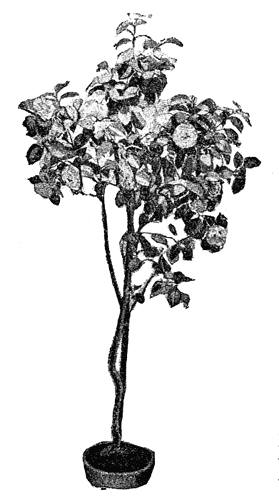
Rice. 148. Camellia
Propagated by cuttings in July-August or in January at the end of flowering in an exploration box at 22 ° C, as well as by grafting in July or January by copulation and lateral grafting on two-year-old cuttings or camellia seedlings serving as rootstocks. The best varieties for rootstocks are S.paeoniflora and Campbel. Young cuttings and grafted plants are kept in cold greenhouses. At the end of growth, pinching is performed for 3-4 buds. Wintering in a greenhouse at 6-7 ° C. In the second year, a camellia bush is formed.
To prepare for flowering, good specimens are kept in a greenhouse in spring at 10-15 ° C, closer to the light, giving abundant watering and spraying. At the end of growth, the plants are kept dry to induce bud formation. When the flower buds become quite noticeable, the plants are taken out into the air for the summer and kept under a light shade made of bars. By autumn, plants with buds are brought into well-ventilated and light greenhouses.
For indoor landscaping, camellias should be placed near light windows facing east. The land is given to plants in the composition of 2 parts of peat, 1 part of leaf, 1 part of turf and 0.5 part of sand.
Camellias, like azaleas, are grown only in the south. In the middle lane, only their content and flowering are beneficial. The best industrial varieties: Chandleri Elegance - double pink-red easily forms buds, does not shed them and is suitable for early flowering, in December, and Campbell - dark pink, not quite double, but with abundant flowering.
Clianthus. Sem. Motylkovs. A beautiful greenhouse dwarf shrub with pinnately-separated leaves, with red and other colors in original colors, with an elongated flag and a keel-shaped boat. One of the most beautiful and graceful plants. Sowing in bowls in March. In April, planting in pots in the ground from a mixture of heather and clay.
The best view is C. Dampieri (bright red flowers with black) grafted on Colutea arborescens seedlings. Cleantus requires a lot of sun and heat. In winter, it is kept in a bright greenhouse at 3-6 ° C.
Cotoneaster. Sem. Rosaceae. Evergreen greenhouse shrubs with leathery leaves, downy and small white or pink flowers below. Propagated by sowing and cuttings. The land is a mixture of turf, leaf and sand. It lends itself well to forming.
The best species are C. buxifolia, C. microphylla, and C. thymifolia.
Libonia. Sem. Akanttov. Greenhouse evergreen, long-flowering, spherical shrubs. They bloom in early spring, and with the addition at 14-16 ° C from February and earlier. The plant requires a lot of light, air and spraying. Afraid of overdrying. Propagated by cuttings.
The most famous: L. floribunda (dense-flowered) and especially L. penrhosiensis - a hybrid for winter flowering with fiery red flowers?
Magnolia (Magnolia). Sem. Magnoliaceae. Greenhouse plants with evergreen leaves. In culture, the following are known: M. grandiflora with large, oval, leathery, light green leaves and large flowers; M. fuscata with smaller, rounder leaves and smaller, fragrant flowers.
It blooms several times throughout the year. Propagated by: sowing in spring under glass with stratified seeds (seedlings are afraid of excessive dampness and cold); hilling young shoots; layering of last year's shoots and grafting in the spring under glass (triangulation). M. Kobus serves as a rootstock, cuttings are cut from two-year-old shoots. The land is soddy mixed with leaf, humus and river sand. Magnolias with falling leaves can go for the attachment. Only large bushes give a large number of buds. The early flowering small-flowered form M. stellata (Halleana) is very beautiful.
Melaleuca. Sem. Mirtovs. An original greenhouse plant, in which flowers are gathered in bunches around the stem, which continues to grow above the flowers. Winters at 3-6 ° C. Propagated by cuttings.
The best species are M. decussata, M. ericifolia and M. thymifolia.
Mimosa. Mimosa pudica. Sem. Mimosovs. An original greenhouse plant with fine feathery leaves, which curl up and down when touched, which is why mimosa is called "bashful". Mimosa is also called "do not touch me" - Noli me tangere. Flowers are small, with graceful heads. Propagated by cuttings and seeds. It is bred more often as an annual plant.
Myrtus (Myrtus). Sem. Mirtovs.Greenhouse evergreen shrubs and trees with small, leathery, aromatic, dark green leaves, with small and fragrant white flowers. Blooms in spring. Propagated by cuttings in spring and June. The land is peaty, turfy with an admixture of sand. In winter it is kept at 3-5 ° C. It lends itself well to forming.
More often than others, there are: M. communis with numerous forms, for example, variegata with edged and painted leaves, italica, M. angustifolia, etc.
Oleander (Nerium). Sem. Kutrovykh. An evergreen greenhouse shrub with flexible stems and leathery leaves.
N. oleander and its varieties: splendens fl. pl. with double pink flowers, album with white flowers, odorum with pale red, fragrant flowers in the shields.
Grows well in sunny places, in summer requires abundant watering. Clay sod land with humus. Blooms in spring and all summer. After flowering, a little pruning is needed.
Propagated by cuttings in sand or water, as well as by layering. Poorly tolerates frequent transplants.
Olea fragrant (Olea), synonym for Osmanthus. Sem. Olive. Evergreen greenhouse shrub. Small white flowers with a delicate aroma are located at the ends of the branches. In China, olei flowers are mixed with the highest grades of tea for a bouquet. Propagated by seeds and cuttings in June. The land is heavy and soddy. Winters in the south. The best species are O. fragrans with white flowers, O. americana with shiny leaves.
Pittosporum (Pittosporum). Sem. Pittospore. Greenhouse evergreen trees. Small white, strongly fragrant flowers (orange scent). Flowering time is spring. Propagated by seeds, immediately after they ripen, or by cuttings in July-August. The land is soddy, leafy and sandy.
The best species: R. Tobira with white fragrant flowers. P. coriaceum - flowers with a jasmine scent. They are used as a material for decorating winter gardens, etc.
Plumbago. (Plumbago). Sem. Svintsovkov. Greenhouse plants: with long, flexible stems, falling leaves and light blue flowers.
Propagated by seeds, division and cuttings. Land in a mixture of turf, peat and sand. Require short annual pruning of 2-4 eyes before growth begins. They bloom in summer and autumn.
The best species are P. capensis, P. pulchella and P. Larpentae.
Punica (Punica granatum). Garnet. Sem. Plakunovs. A greenhouse shrub with quadrangular branches and falling, lanceolate leaves. Large red flowers, simple or double. The cup of the latter looks like a portbouquet with densely collected wavy petals. Dwarf potted pomegranates are covered with flowers.
Propagated by cuttings. The land is strong, clayey-soddy with an admixture of manure. Blooms in spring on summer shoots. In summer, it must be exposed to a sunny place. Requires abundant watering and liquid fertilization. For the winter they clean up in the basement.
The dwarf form of P. g. daddy is a wonderful potted plant. Old pomegranates bloom well in tubs.
Rosean Chinese. (Hibiscus) (Rosachinensis). Ketmia. Sem. Malvovs. Shrub for greenhouses, greenhouses and indoor landscaping. The flowers are funnel-shaped, simple and double. It blooms from mid-summer to early winter, and some varieties from spring. After transplanting, a short cut is given.
Propagated by herbaceous and woody cuttings throughout the year; takes root equally well. Not whimsical to the soil. It is developing rapidly. One of the best indoor gardening plants,
Rhododendron. (Rhododendron). Sem. Vereskovykh. Small trees or shrubs with elongated elliptical evergreen leathery leaves and beautiful tubular flowers in umbrellas. Propagated by sowing, cuttings and grafting. Hybrids of Himalayan rhododendrons with North American species, known as "Dutch rhododendrons", are cultivated. When inoculated, the stock is R. caucasicum. The culture is the same as that of camellias and azaleas.
Often found - R. ponticum synonym - Azalea pontica with falling leaves. It is used for forcing.
Swainsonia. (Swainsonia). Sem. Motylkovs. Greenhouse dwarf shrubs with moth flowers.Propagated by sowing and cuttings. Land made from a mixture of turf, peat and sand. S. galegifolia has brilliant red flowers with a vanilla scent.
Franciscea Brunfelsia. Sem. Solanovykh. Greenhouse shrub with large fragrant flowers in the form of a thin tube with a wide, flat limb. Blooms from spring to autumn. Perfect plants for indoor gardening.
Propagated by seeds and cuttings. Good growth requires a soddy, humus-rich land; in summer - frequent spraying. The most famous are: F. calycina (tashechnaya) with large purple flowers; F. eximia (graceful) with matte leaves; F. divaricata; F. Hopeana — uniflora (one-flowered) and F. latifolia (blooms in winter).
Fuchsia (Fuchsia). Sem. Onagrikov (fig. 149). Greenhouse shrubs or trees. Plants are evergreen, although in winter at low temperatures (5-7 ° C) or with insufficient watering, the leaves fall off. The flowers are mostly drooping, simple and double, with a four-lobed, curved upward limb. Flowers have the most varied colors.
|
Cup |
Corolla |
|
white …………. light red …… .. brilliant red …… .. red ………… shoriekhovaya ……… |
pink red white pale pink purple |
Propagated by apical herbaceous cuttings, starting in February. Rooted cuttings are planted in pots placed in a warm greenhouse, from where young plants can be planted directly into flower beds, balcony and window boxes, where they bloom. Fuchsias cannot stand the bright sun. Plants can be grown in tall standard form. Fuchsia stamps, arranged in rows and connected with garlands of other plants, represent a very beautiful view. Before freezing, the plants are removed from the flower beds. If they are without pots, then they are planted in pots and put in a cold greenhouse for the winter. At home, fuchsia gives delicious, fragrant berries.
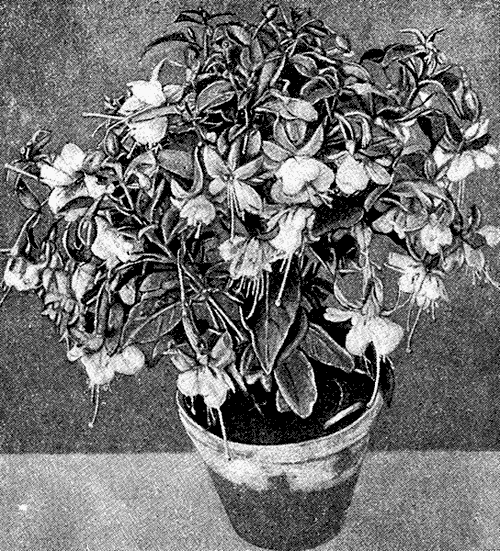
Rice. 149. Fuchsia
The best potting varieties: Coralle, A. Sieberti. G. Vornemanii. For standard fuchsias, strongly growing varieties serve as stock. Weeping varieties are used for balconies: Frailing Queen, Marinka. For amples - F. procumbens. Irreplaceable balcony plants.
Centradenia. Sem. Chernoustovs. An evergreen shrub with shiny leaves with red nerves below and beautiful pink-red flowers. The special value of this plant lies in the fact that it blooms from November to March, that is, in a period poor in flowers. Propagation by seeds and cuttings. The best view of S. floribunda.
Cytisus (Cytisus). Broom. Sem. Motylkovs. Wintering, greenhouse shrubs with trifoliate leaves and fragrant moth flowers. It blooms in late winter and spring. Propagated by seeds, cuttings and grafting on Laburnum vulgare.
The soil is loose, sandy. After flowering, it is transplanted. At the end of May, it is taken out into the air in a sunny place. Frequent pinching in June.
The best species and forms: C. albus (white), C. Dallimorei (light purple), C. nigricans (blackish), C. praesokh (yellow), C. canariensis (yellow), C. Scoparins var. andreanus (bicolor).
Citrus (Citrus). Sem. Rutovs. Trees or shrubs belonging to the genus citrus have beautiful foliage, fragrant flowers and decorative edible fruits. Citrus fruits are high quality dessert and dietary fruits rich in vitamins. Lemons, for example, protect against sclerosis and sclerosis.
The name of cultivation premises - greenhouses, from the French word "oranger" - an orange tree is also associated with the culture of citrus fruits.
More recently, it was said that citruses are the culture of the future. However, already at the present time, the culture of citrus fruits enjoys great attention in the Union. On the Black Sea coast, citrus fruits are cultivated outdoors. If in 1933 there were 2,876 hectares under citrus trees on the Black Sea coast, then in the coming years this area should increase significantly. According to the instructions of the party and government, Transcaucasia in 1937 should provide half a billion lemons, oranges and tangerines.
The citrus culture achieved great success in g.Pavlovo and the collective farms of the Gorky region surrounding the city, where you can find several citrus plants in almost every house. Citrus culture in Pavlov has been going on for over 100 years. Lemons and citrons predominate, tangerine and orange are much less common, since the latter in room conditions, apparently, from a lack of sunlight, acquire excessive acidity.
Lemons and other citrus fruits need to figure prominently not only in solving the problem of indoor gardening, but also in obtaining their valuable fruits.
"Lemons," as Comrade Lisitsyn, People's Commissar of Agriculture of the RSFSR said, "should be regular guests at our table."
Lemons can be grown indoors in any area of the Union. There are already amateurs practicing lemon culture in the far north, on the island of Svalbard.
The culture of lemons must be introduced into schools, collective farms, work apartments, holiday homes, etc.
Citrus fruits usually bloom twice a year: in spring - in March-April and in autumn - in October.
Even under conditions of primitive care at 2-3 years of age, lemon and orange plants in Pavlov give 8-12 fruits, and sometimes up to 20-23 fruits. Artificial pollination can increase yields, since without artificial pollination, ovaries form no more than 75% of the total number of flowers.
You can make every lemon tree bear fruit annually. One seven-year-old lemon tree grown in a room produces 25 to 30 lemons a year in the northern regions and 100 to 200 lemons in the southern regions of the Union.
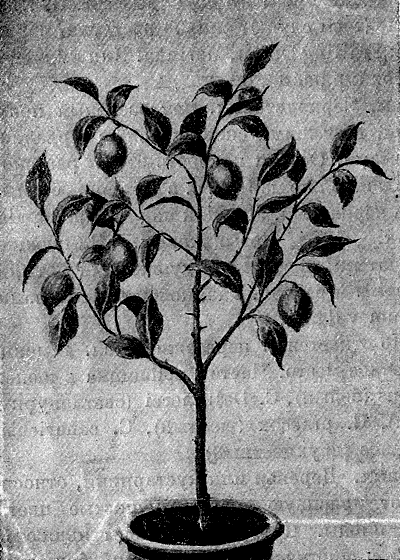
Rice. 150. Lemon
From citrus fruits for pot culture can go: lemon (C. limonia) (Fig. 150) sweet, orange (C. csinensis) (Fig. 151), tangerine (C. nobilis), extremely fragrant and abundantly flowering orange (C. bigaradia multiflora), citron (C. medica), pompelmus (C. grandis), sour orange (C. aurantium praecox), etc. Much attention should be paid to the culture of grapefruit (C. paradisi), which tolerates room maintenance better than other citrus fruits. Grapefruit has wonderful taste, is aromatic and sweet, like an orange, has a pleasant lemon acidity and some bitterness. Grapefruit has a bright orange fragrant rind and is high in vitamins.
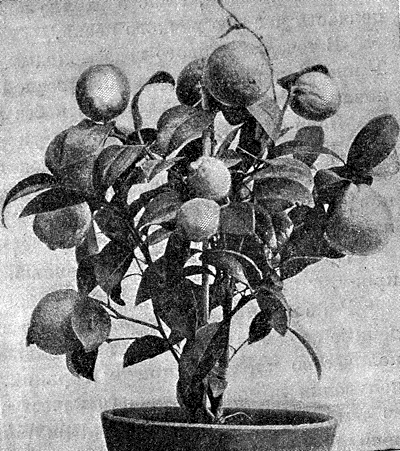
Rice. 151. Orange
Among the varieties of lemon, we can recommend: Pavlovsky lemon and the very fruitful Meyer's lemon, which is very famous (for a tub culture).
Reproduction of citrus fruits is done by cuttings and grafting.
Own-rooted lemons, that is, obtained by cuttings, usually bear fruit in the second year after rooting, that is, those previously grafted. Cuttings can be obtained in Moscow from the Green Building Trust, in Batumi from the Trust of State Farms of Adjarastan, in Sukhumi from the Trust of State Farms of Abkhazia, in Tbilisi from the All-Union Lemon-Tangerine Trust.
Reproduction of own-rooted lemons. The middle part of a semi-woody twig of a healthy strong fruiting plant with quite healthy mature leaves is taken on the cuttings. Cuttings are cut into a length of 10-15 cm with 4-5 nodes or buds. The lower end of the cutting is cut 1/4 cm below the knot, and the upper end is 1 cm above the knot. For better rooting, the cut is made slightly obliquely, almost straight. The best time for grafting is July-August, although grafting can be done all year round. It is necessary to ensure that the cuttings do not dry out during storage. To do this, the upper cut of the cutting is coated with garden varnish and dipped in a vessel with room water, or the cuttings are wrapped in moist steamed moss.
Before planting the cuttings, the pots are disinfected by steaming. To drain excess water and access air, drainage is arranged at the bottom of the pot. The drain hole is closed with a crock - hump up. On top of a quarter of the height of the pot, a layer of fine gravel or crushed charcoal is poured. The drain is covered by 1 cm of steamed moss. On top of all this, a mixture of old humus and sod land is poured by 10 centimeters. The earth is moistened with warm fresh water.
Cuttings also root in clean coarse river sand.
The cuttings are planted in a checkerboard pattern, 5 cm apart and at a depth of 2 cm, in a slightly inclined position. To preserve air humidity, pots are covered with a glass cover or glass plate and kept in a bright place, but not on the sunny side.
The soil is kept moderately moist and the cuttings are sprayed daily. Rooting of cuttings occurs in about two decades, at 30-35 ° C. Rooted cuttings are planted in 10-12-centimeter pots at the same depth at which they sat during rooting.
Land when planting is given in a mixture of 2 parts of sod land, 1 part of deciduous land, 1 part of completely decomposed greenhouse manure and half a part of clean river sand.
During the first year, young plants are given (if necessary) 2- or 3-fold transshipment in the spring, at the beginning of July and in the second half of August, if possible without destroying the earthen coma.
Pavlovna also use rooting of cuttings in water.
For a more successful rooting of cuttings, they resort to various methods of heating the pots. Practices, for example, are immersion of cuttings pots 1/3 of the height in a hot greenhouse and electric heating of cuttings boxes.
By pinching young rooted plants (2-3 times) create a crown.
Propagation of lemons by grafting. Lemons, derived from seeds, bear fruit no earlier than 15 years later, give a small amount of fruit and, moreover, bitter. To accelerate fruiting and obtain good quality lemons, lemon plants derived from seeds are ennobled by grafting — budding (with an eye) or copulation (cuttings) in the 2-3rd year of their life. In indoor conditions, budding is preferred. At room grafting, in order to avoid drying out of the surface of the cut of the eye, it is sometimes dipped in fresh lemon juice until it is injected under the skin. Vaccinated mainly in March and July. The stock is a three-leafed lemon - Poncirus trifoliata and, in general, lemon plants obtained from lemon seeds.
It should be noted the Dzhuruk lemon, which has the peculiarity that when propagated by its seeds, lemon plants are obtained that do not need grafting.
For the widespread introduction of lemons, it is necessary to collect lemon seeds, sow seeds, inoculate and propagate by cuttings.
Lemon seeds germinate easily, but in winter it is better to germinate them in a thermostat at 20 ° C. In the latter case, it will take about 1.5-2 decades to get seedlings.
Citrus care. Annual fruiting of citrus fruits depends on proper and careful care of them. Such care consists in timely transplantation, proper watering, pruning, fertilization, pest control and rejuvenation.
Citrus plants are exposed to the air for the summer, where they decorate gardens, verandas, balconies, etc. In winter, citrus fruits are best kept in cool rooms at 5-7 ° C in order to prevent premature unnecessary and harmful growth. For Pavlovtsi, in summer and winter, citrus fruits remain in their rooms.
Citrus transplants are performed the less often, the older the plant (young - after 1-2 years, older - after 3-5 years, and old trees after 5-8 years). The soil should be nutritious, but fresh humus. When watering citrus fruits, you should strive to keep the earth in a moderately moist state.
Pruning has two goals: the formation of the correct beautiful crown of the plant and the regulation of fruiting - getting as many short fruiting branches as possible.
When cultured in rooms, the best form for citrus fruits is a bush, i.e. when the plant branches out almost at the very ground. The first pruning is done in the spring, before growth begins; the second - in August; the next pruning is next spring.
Escape from a peephole or rooted cuttings, depending on what height it is desirable to obtain a bole, is cut at a height of 5-10, 10-15 or 20-25 cm. The eyes of the remainder of the shoot give from 3 to 6 branches. In August, these branches are cut off, leaving no more than 3-4 eyes on each, from which, in turn, new branches develop.When trimming the latter, only 2-3 eyes are left. As a result, in the 3-4th year of the life of a rooted cuttings or shoot that has developed after budding, you can get a plant with a beautiful crown shape.
Pruning to maintain crown shape and fruiting. The most convenient size of a lemon tree is considered to be a height of 175 cm and a width of 150 cm. In this case, pruning is done for 2 eyes, and if the branches are unnecessary, for a ring, that is, the branches are cut off at their base. Branches that go inside the crown and are not needed for its completeness are removed. The ends of the branches that extend beyond the crown are cut off. Since lemon bears fruit on small branches, they try to get as many of these branches as possible by pruning. Therefore, small branches that were with fruits are cut into 1-2 eyes. If there are enough fruit branches, then fatty long branches, that is, strongly growing ones, are cut into a ring. If there are few fruit branches, then the fatty shoots are also cut by 1-2 eyes. Dry branches are cut into a ring. Places of cuts are covered with garden pitch.
Fertilizing citrus fruits. In summer, citrus fruits need not only abundant watering, but also fertilization. The latter increases the sugar content of the fruit and reduces the bitter taste that citrus fruits get at room culture. The plant needs more fertilization, the older it is and the longer it is in the same container. Fertilizers are applied after watering.
Agronomist Kipper recommends a slurry of cow dung or poultry manure and combined mineral fertilizers for fertilizing citrus plants.
Citrus fruits suffer from scale insects, red spider, and leaf spot. Spraying the plants with water is used against the spider. Spraying generally benefits the plants. The worms are cleaned with a brush dipped in a solution of green soap. After a few hours, the soap should be washed off with water.
Rejuvenation of lemon trees is carried out at the age of 14-20, that is, when their fruiting decreases. In this case, in the spring (March-April), all large and medium branches are cut into 3-4 eyes, and the lateral ramifications of these branches are cut into a ring, with the exception of one lateral branch with 1-2 young shoots. But these side branches also
|
Age |
Goo |
Mineral fertilizers |
|
1st year of life 2nd "3rd" 4th and 5th years of life 6th and 7th "8th and 9th" 10th and older |
do not add 1/4 cup 1/2 "do not add 3 cups 4" 5 cups |
1/4 cup No. 1 1/2 "No. 1 1/2" No. 1 1 "No. 2 5" No. 2 6 "No. 3 8" No. 3 |
|
The composition of mineral fertilizers |
No. 1 (2 l of water) |
No. 2 (4 l of water) |
No. 3 (5 l of water) |
|
Ammonium sulfate …… Superphosphate …… .. Silvinite ………. |
3 g 2 "1" |
5 g 3 "4" |
6 g 4 "5" |
can be cut into a ring if new shoots develop on the remaining parts of the main branches.
The rejuvenated plants are transplanted into new dishes, and the roots are shortened by one third to obtain more new roots.
Eriostemon. Sem. Diosmovs. An evergreen shrub with very abundant flowering in spring. Propagation by cuttings. The most common species are with white and pale pink flowers.
Escallonia. (Escallonia). Sem. Stonefragments. Evergreen greenhouse shrubs. Five-petalled bell-shaped flowers are collected at the ends of the branches. Propagated by cuttings and layering. Winters at 4-6 ° C. Best species: E. floribunda with white flowers, E. Philippiana with white fragrant flowers, E. macrantha with red flowers.
Justice (lusticia). Sem. Akantov. Greenhouse dwarf shrubs with beautiful flower spikes. Requires the same culture as Afelandra. The best species is I. carnea (flesh pink) with varieties magnifica and speciosa.
FORTUNE SHRUBS
In winter (during the dormant period in most plants), there are few flowers. Meanwhile, there is a full opportunity to receive a sufficient number of colors at this time.
There are a number of shrubs that, under certain conditions, bloom no less abundantly in winter than in spring. Many shrubs lay flower buds in the fall.This makes it possible in conditions of artificial heat, even in low light, to get completely normal flowers. Moreover, some shrubs can be in bloom before the new year, others later.
By flowering time, shrubs can be divided into three groups:
1. Early forcing shrubs (December-January); these include: Japanese quince, acacia, glycine, golden rain, viburnum, prunus, lilac and forsythia.
2. Mid-early forcing shrubs (February-March): weigelia, spirea, etc.
3. Late forcing shrubs (April-May): hydrangea, action, garden jasmine, clematis, broom (cytisus).
The success of forcing shrubs depends on the ability to prune them. Shrubs whose flower buds sit directly on last year's shoots should be cut off only after flowering. This pruning will cause the formation of new young shoots. Late forcing shrubs include: quince, acacia, hawthorn, glycine, golden rain, prunus, lilac, forsythia and apple tree.
Shrubs whose flowers sit on short shoots growing from last year's wood need to be shortened before flowering to improve the quality of the flowers. These include: action, weigelia, jasmine, viburnum, clematis, broom, spirea (S. arguta).
Finally, shrubs, the flowers of which appear at the ends of long young shoots, require short pruning of 2-3 eyes before being added. Such shrubs are: hydrangea and spirea (S. Bumalda, Japanese spirea), roses.
For forcing are mainly shrubs with falling leaves (deytion, jasmine, prunus, lilac, forsythia, etc.).
Shrubs intended for winter flowering, 1-2. years before forcing, they are planted from the ground in pots in the spring before the start of growth or in the summer after the end of the first growth. By pruning, taking into account the individual characteristics of individual plants, the desired bush shape is obtained. With the onset of frost, forcing plants are brought into a cold, non-frosty room, and by the time of forcing they are placed in a racing greenhouse, where the plants bloom.
The following is a description of 1) early forcing shrubs, 2) mid-early forcing shrubs, and 3) late forcing shrubs.
1) The best early forcing shrubs include:
Japanese quince (Cydonia japonica, synonym for chaenomalis). Sem. Yablonev. Terry garden forms sanguinea plena, atrococcinea plena are especially beautiful. C. Maulei has a lower stature, which at a young age is completely covered with small red flowers.
Propagated by layering of last year's shoots and hilling young shoots in June-July.
False acacia (Robinia hispida). Sem. Mothykovs. A beautiful shrub with pink flowers in clusters. Easily forcing early. The flowers are very delicate, like glycine.
Propagated by grafting - triangulation or by bark - in a greenhouse and in the ground on seedlings of R. Pseudoacacia.
Hawthorn (Crataegus). Sem. Yablonev. Good for potting and vat culture, as well as for winter forcing. Terry varieties of C. monogyna are of great decorative value, namely: Candida plena with white double flowers and kermesina plena with dark red double flowers. Blooms for a long time.
Propagated by budding on seedlings of the main species.
Glycine (Glycine, synonym for Wistaria) (Fig. 152). Sem. Mothykovs. Forcing shrub. Best Race Forms: G. chinensis with white and blue flower clusters and G. multifuga with very long flower clusters. It is cultivated in trellis and weeping form on boles. In order to induce the formation of flower buds at the base of the branches, the plant is subjected to systematic pinching during the summer.
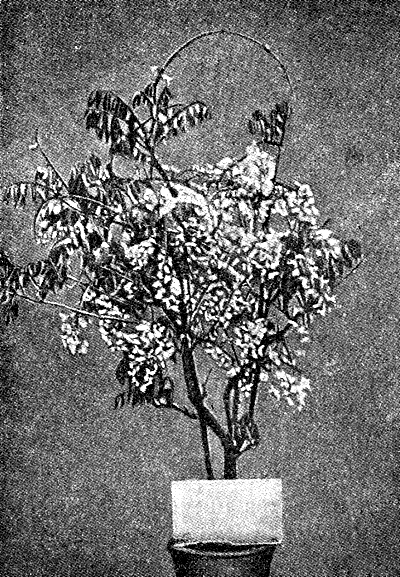
Rice. 152. Glycine
Reproduction by layering of last year's shoots, sometimes cut off from the mother bush. Rooted in the grooves. At the end of summer, cut into as many pieces as there are rooted eyes.
Golden rain (Laburnum vulgare) (Fig. 153). Sem. Mothykovs. Fragrant yellow flowers in long drooping racemes. The best forcing forms are L. watereri with very large inflorescences, L. adami with red and yellow flowers, and L.Alschingeri with yellow flowers.

Rice. 238. Golden Shower
The main species reproduces by sowing seeds in the spring. Before sowing, the seeds are scalded with boiling water and wetted for 2-3 days. Other forms reproduce by grafting on seedlings of the main species. L. vulgare.
Kalina (Viburnum). Sem. Honeysuckle (Fig. 154). After lilac, viburnum takes second place as an industrial-racing mass shrub. The best species: V. opulus sterile - "Snow Globe" and V. tomentosum var sterile - a low, spreading shrub with large balls of white flowers.
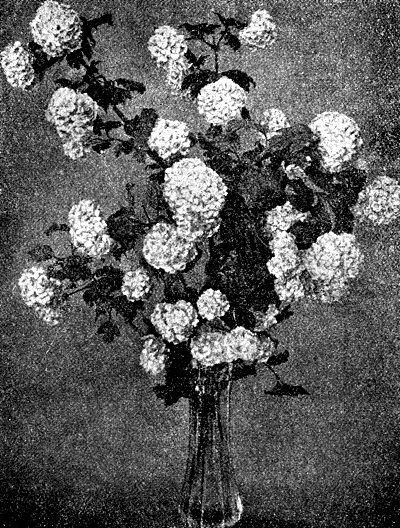
Rice. 154. Terry viburnum
It propagates easily by horizontal layers of the entire shoot into grooves, thus giving many young plants. It also reproduces well with green and winter cuttings from annual wood.
Prunus. Sem. Almondyevs. This genus includes many decorative forcing groups of shrubs, namely: cherries, plums, sweet cherries, almonds.
Cherry group includes: Pr. chinensis (japonica) - Japanese cherry with double forms alba fl. pl. and rubra fl. pl .; Prunus pendula - Japanese weeping cherry (Fig. 155); Pr. serrulata is a Japanese large-flowered cherry with forms: Hisakura. ochichima and Shidare Sakura.

Rice. 155. Japanese Weeping Cherry
The latter deserve the most attention.
Pr belongs to the drain group. triloba fl. pl. - Chinese terry plum (fig. 156). Cultivated in bush and standard form.
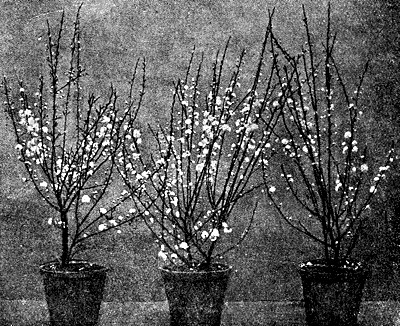
Rice. 156. Chinese Terry Plum
Pr belongs to the group of cherries. avium fl. pl. - terry cherries. Pr belongs to the almond group. persica (Amygdalus persica) - peach with its double forms; Clara Meyer is a particularly abundant flowering, double-flowered variety; Pr. communis (Amygdalus communis) - common almond. For distillation, its double forms are used: carnea plena, rosea plena and Pr. nana (Amygdalus nana) - bean or steppe almond. The main species used for grafting on rootstocks are communis, persica, papa, avium, japonica, serrulata.
Propagated by seeds. Seeds should be stratified immediately after collection. Sowing in autumn on the ridges sprouts in spring. Pr propagates by layering and hilling. japonica (also succeeds in herbaceous cuttings).
However, the most common method is grafting in the spring with a cuttings, and in the summer by budding. As a rootstock for cherries and sweet cherries, in addition to seedlings of the main species, Pr. cerasus is a wild and cultivated cherry. For plums and almonds, the best dwarf rootstock is Pr. spinosa (turn).
Forsythia (Forsythia). Sem. Olive. The flowers are yellow. The best types for pot culture: F. suspense (drooping); flowers appear before leaves; F. viridissima (dark green); F. intermedia densiflora (fig. 157) and spectabilis.
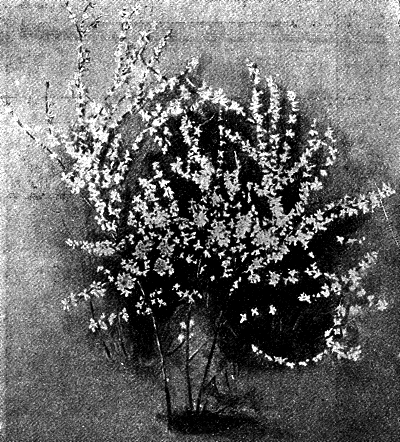
Rice. 157. Forsythia
Propagated by herbaceous cuttings in early summer.
Apple tree (Malus). Sem. Yablonev. Decorative apple trees are a very elegant decoration in winter. The best species are M. Scheideckeri with double pink flowers and M. floribunda (multicolor) with its atropurpurea variety with dark red flowers.
Propagated by budding on dwarf rootstocks of paradizka, dzheni and Turkestan dwarf apple trees ("Arabian baba").
2) The best mid-early (February-March) forcing shrubs include:
Weigelia (Weigelia-Diervillea) (Fig. 158). Sem. Honeysuckle. Abundantly flowering shrubs with graceful growth. Top racing strains: Eva Rathke with deep red flowers, Bouquet rose with silky pink flowers and Fleur de Mai with purple pink flowers.
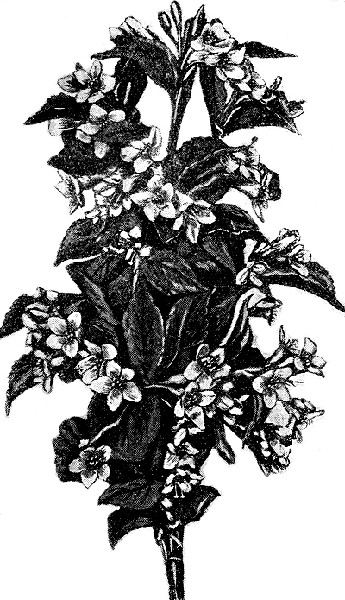
Rice. 158. Weigelia
Propagated by winter cuttings under glass or grassy ones in summer.
Spirea (Spiraea) (Fig. 159). Sem. Rozanovs. Shrubs producing large quantities of cheap cutting material. The best forcing varieties: S. arguta of short stature, snow-white with unusually abundant flowering; S. Thunbergii - Japanese white spirea; S. Van Houtti - long-blooming white spirea; S. prunifolia - low, stemmed, terry; S. pumila Bumalda with bright red flowers and. S. (Exochorda) Alberti macrantha is the most beautiful and abundant form.
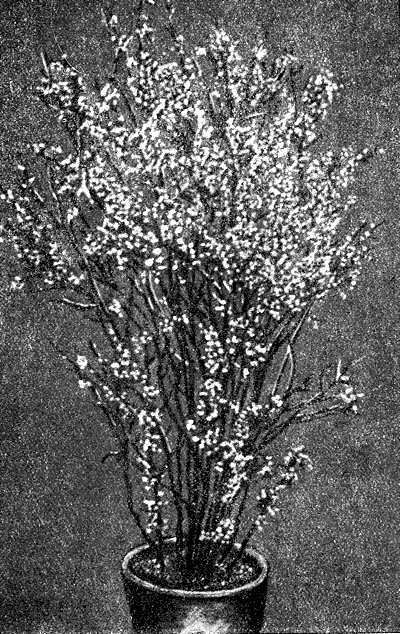
is. 159. Spirea slimy
Propagated by hilling young shoots (Van Houtti and arguta) and herbaceous cuttings in a greenhouse from mother specimens, and in greenhouses from soil plants.
3) The best late (April-May) forcing shrubs include:
Deytsiya (Deutzia). Sem, Kamnelomkovs. A shrub that usually blooms in spring with white and pink flowers. The best species for forcing in moderately warm greenhouses is D.gracilis with forms D. Lemoinei (Lemoine). (fig. 160) in varieties: Avalanche, Boule de Neige, Boule rose and compacta.
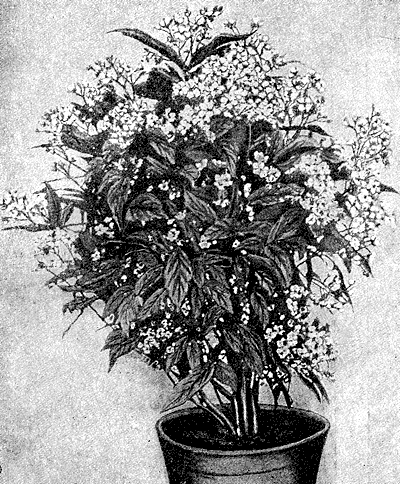
Rice. 160. Action Lemoine
Propagated by herbaceous cuttings in the same way as spirea.
Garden jasmine (Philadelphus) (fig. 161). Sem. Chubushnikovs. Favorite garden shrub with fragrant flowers. For the pot culture, there is a Lemoine hybrid of dwarf growth with abundant flowering.
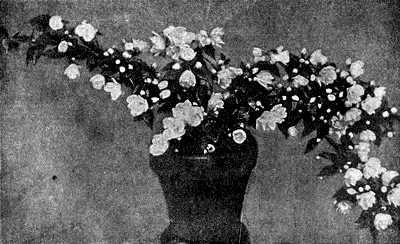
Rice. 161. Philadelphus (Garden Jasmine)
Propagated by herbaceous cuttings in the same way as spirea.
Clematis. Sem, Buttercup. Extremely beautiful large-flowered hybrids are used for forcing.
It reproduces in greenhouses, under glass with cuttings of last year's shoots, cuttings from semi-mature wood in July-August, grafting roots on bushes (split) in the spring in a greenhouse, and in July-August in the open air.
Cytisus (Cytisus). Broom. Sem. Motylkovs. Shrubs of southern European origin. Close to Golden Rain. The best species for potting are: C. praesoch - early flowering with yellow flowers and C. Andreanus with yellow-red flowers.
Propagated by herbaceous cuttings in the second half of summer in greenhouses and by grafting in a greenhouse on C. nigricans seedlings. Cuttings are taken with two-year-old wood.
HERBAL PLANTS
Begonia (Begonia). Sem. Begonievs. There are two main groups.
1) evergreens with erect and creeping stems and
2) tuberous, shedding greens for the winter.
The most important representatives of the first group are:
from greenhouse forms - Rex deciduous begonia and Creednery begonia;
from shrubs and semi-shrubs - evergreen flowering begonias: B. metallica, B. Zebrina, B. maculata, B. Olbia, B. Schmidti, B. Sutterlandii;
from greenhouses - Gloire de Lorraine (V. Gloire de Lorraine), Glory of Lorraine, winter-flowering hybrid of V. socotrana with V. Dregei. By crossing B. socotrana with tuberous begonias in England, large-flowered hybrids of winter-flowering begonias with very long flowering were obtained. The latter in culture are more demanding than the begonia Glory of Lorraine. The most noteworthy varieties are: Winter Perfection, Ensing, Elatior, Eclypse.
Of the tuberous begonias, the most famous varieties are B. hybrida with simple and double flowers.
Begonia Rex (fig. 162). A low plant with a creeping stem with ornamental, broadly oval, lopsided painted leaves with a heart-shaped base. Rex begonia leaves of the most varied colors: bronze-brown with silvery spots, silvery-pink, silvery with a red-metallic sheen, etc.
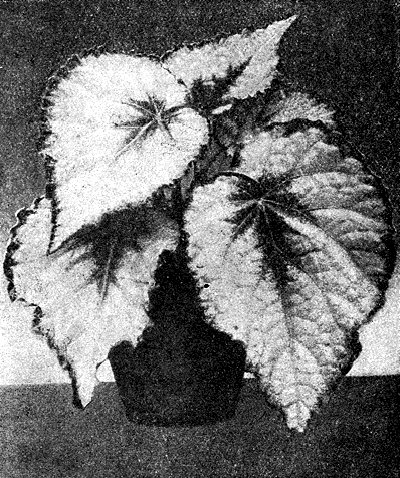
Rice. 162. Begonia Rex
Begonia Rex reproduces with whole leaves crushed by pegs or glass scraps to the sand in a warm exploration box or on a greenhouse rack. It is first necessary to make transverse cuts on the leaf veins at the bottom of the sheet. The sheet should be in close contact with the sand. New plants are formed at the incision sites. Some cultivators cut the leaf into triangular pieces formed by the leaf nerve and place them in rooting bowls. Begonia Rex can also be propagated by seeds and cuttings.
Begonia Gloire de Lorrain is a hybrid between V. socotrana and V. Dregei. One of the most important plants for indoor gardening. With good culture, when propagated by leaf cuttings, it reaches 45-50 cm in height and the same width. It blooms profusely with beautiful pink flowers of various shades, in autumn and winter.
Propagated by stem and leaf cuttings. Uterine specimens prepared for grafting at a temperature of 15-17 ° C, already in February-March grow and give good shoots at the base of the bush from the lower buds or from the ground. Apical shoots are not taken on cuttings, since they do not give good growth and tend to bloom prematurely. The cuttings are planted in an exploration box in a mixture of peat and river sand. Since rooting is easier in the stale air, boxes with cuttings are covered with glass.
The temperature is maintained at about 22-25 ° C. Watering should be done carefully.
After rooting, young plants are planted in 4-centimeter (1 vert.) Pots, which are placed in a warm greenhouse or on the shelves of an exploration greenhouse.
Plants are selected for mother plants in the fall. They are not allowed to bloom, for which the shoots are cut to 1 / 3-1 / 2 of their length. Throughout the winter, flowering shoots are destroyed in order to induce strong growth.
The best time for propagation by leafy cuttings is August. Well-ripened leaves with a heel go to the cuttings.The leaves are planted with the end of the petiole in an exploration bed at a very shallow depth. The temperature is maintained at 22-25 ° C. Rooting occurs in 3-4 decades. When young roots appear at the base of the cutting, the plants are transplanted.
The advantage of such propagation is that it produces plants that are more highly developed and less prone to flowering at a young age than plants derived from stem cuttings. At first, the land is given in a mixture of peat, leaf and sand, and later - from leaf, light turf and sand. On sunny days, plants need shading and spraying.
In the culture there are many new varieties and varieties of the begonias of Gloire de Lorrain, characterized by fast, strong, straight growth, large, juicy green leaves, luxurious, large, showy flowers. There are ampelous forms.
Hybrids of Gloire de Lorraine with tuberous begonias resemble Gloire de Lorraine with their leaves, and flowers resemble tuberous begonias with double or simple flowers. In their color, these hybrids are superior to Gloire de Lorrain - the whole question is in their greater complexity and exactingness in culture. Gloire de Lorrain blooms from October to February-March, depending on the variety. The best varieties such as Competitor and Competitor compact are distinguished by stronger growth and richer flowering.
Begonias must be strongly fertilized from the very beginning of growth, mixing horn shavings, horn flour, dry mullein, etc. to the ground. conditions, begonias grow better. Upon reaching 5-7 cm, the plants are pinched. Subsequently, pinching is repeated 1-2 times to get a bush.
Bush begonias are herbaceous plants that grow into beautiful bushes, often reaching high growth with abundant flowers. Shrub begonias sometimes have beautifully colored and painted leaves. Propagated by cuttings or seeds in February-March. Seedlings after two or three picks are planted in pots. The culture and care of seedlings are the same as for cuttings.
The best bush begonias include: B. fuchsioides up to 1 m in height, with beautiful leaves, with small cinnabar-red flowers in drooping scutes; B. incarnata superba up to 50 cm in height, with bronze-colored leaves and flesh-colored flowers, resembling abutylene, on drooping pedicels; B. Schmidti - a short bush, all summer in the colors of a flesh-red color scheme; B. Scharffiana with white flowers; B. Credneri with matte pink flowers; B. Digswelliana with salmon-red flowers B. albopicta with white-spotted leaves and white flowers and B. mettalica with very long flowering.
Begonia semperflorens propagates mainly by seeds (it is possible also by cuttings (see annuals).
Tuberous begonias. Tuberous begonia belongs to the tuberose begonia of a hybrid with simple and double flowers. Blooming in summer. This begonia loses its leaves for the winter. Tuberous begonias enjoy great attention when decorating flower beds, balconies, and rooms. Tuberous begonias propagate by seeds, cuttings and, in rare cases, by careful division of tubers. Reproduction by seeds is similar to begonia semperflorens (see annuals).
Mature plants are planted in pots for indoor landscaping, or they go for cleaning flower beds with planting directly in the ground or in pots. Before the onset of autumn matinees, begonias tubers are selected from the ground, dried and stored in a dry, frost-free room, buried in sand or peat powder. The next spring (March-April) the tubers are germinated and put into cultivation.
Dutch carnation (Dianthus caryophyllus) (Fig. 163). Sem. Cloves. There are five groups of Dutch carnations: 1) potted non-repaired carnation (D.caryophyllus fl.pl.) - Topfnelken, 2) potted carnation, 3) French carnation, 4) German giant carnation, 5) American always blooming carnation.
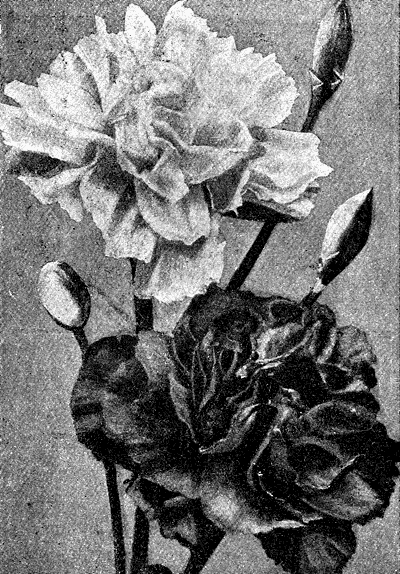
Rice. 163. Dutch Carnation
1. The potted non-renovated carnation is distinguished by its hardiness and large double flowers. Flowering is short - June. Due to the variety of petal colors, one-color and multi-colored flowers are presented in all tones and variations.
Reproduction is carried out by seeds and cuttings, rarely by layering after flowering. Rooted cuttings and cuttings are planted in 9-cm (2 vert.) Pots, in a mixture of clay-turf and compost soil. Until Severe frosts, they are kept in greenhouses with moderate watering and frequent ventilation. For the winter, they are removed to a bright, cool greenhouse, where they are kept until spring at low temperatures and strong ventilation. In April, plants are transplanted into 13-centimeter (3 vers.) Pots in which carnations bloom. The best varieties: White Queen, Titania - pink; The glory of Frankfurt is fiery red; Mrs Taylor - yellow Oberon - chestnut
2. Potted carnation is distinguished by its unpretentiousness in culture. It can be successfully grown in primitive greenhouses. Due to its low stature, it is especially suitable for potting. Blooms mainly in May-June; The varieties bloom well in winter: Winner - red, Agadir - pink; Success is white with red and the North Star is white.
3. French repair carnation. It is characterized by strong growth and very large, densely double flowers. Among the potted carnations it takes the first place. Bloom October-November and March-May.
Propagated in July-August by cuttings, which are cut with 3 knots and planted in a semi-warm greenhouse, in sandy ground. The cuttings are kept under the shade and with the frames closed. Rooting occurs in 1 / 2-2 decades, after which the cuttings are hardened in sunlight with open frames. After the roots and the plant are sufficiently strong, they are planted in 7-9-centimeter (1.5-2 vert.) Pots, allowed to take root in a greenhouse, and for the winter they are removed in a cold light greenhouse.
All carnations need a constant supply of fresh air. In May, carnations are planted on ridges in clay soil fertilized with compost. Carnations do not tolerate fresh manure fertilization. After rooting, a pinch is done to form a bush. Flower arrows appearing before mid-June are removed. In late July - early August, the bushes are planted in 13-15 cm (3-3.5 vert.) Pots with good drainage. For rooting, they are placed in a cold greenhouse, under frames and a light shade. Often sprayed and ventilated. After rooting, the frames are removed. Until autumn, the formation of flower arrows and buds takes place. The buds do not tolerate matinees well, so the carnations should be removed in advance in bright greenhouses.
In winter, the plants are kept at 7-10 ° C. Plants that have not formed buds until mid-September are cut by half and left for further culture the next year. Do the same with faded plants.
When cultured for cutting, plants are planted in the spring on shelving soils in greenhouses with water heating and removable frames. In the fall, before the onset of frost, frames are placed, strongly ventilated, and the temperature is maintained at 7-10 ° C. Cut flowers are obtained from such rack soils throughout the winter.
The best varieties: Gardenia - white, La Patrie - fiery red, Triumphe de la Republique - cherry red.
4. The German gigantic, remontant carnation is a hybrid between the remontant carnation and the American ever-flowering carnation.
A valuable feature of this group is that, along with large flowers and rich flowering, it is possible to receive cut flowers in greenhouses continuously from August to November. To get flowers in August, the carnation is pinched, which should be finished at the end of May. When pinched before the beginning of July, the carnation blooms in April-May.
The best varieties: Snowflake and Snow Avalanche are white, Siebreiz and Rosa Konigin are pink, Vulkan is red, etc.
5. The ever-flowering American carnation is the best repaired carnation with large flowers on long stalks. Differs in very long flowering.
Propagated by cuttings. The best time for cuttings is January - April. Lateral shoots are taken on cuttings at the base of the stem. They should not be too soft or hard. Cuttings are carefully torn from the stem and planted tightly in clean sand. For rooting, the cuttings are kept at 18–20 ° C of soil heat and 12–15 ° C of air, under the shade.
Care consists in spraying. Full rooting occurs after 3 decades. After proper hardening, the plants are planted in rack soils 6-8 cm deep in clay-turf soil. Carnation does not tolerate deep planting. The planted plants are not watered, but only sprayed and kept under the shade. After rooting, the carnation is cultivated at 10-15 ° C. At the end of May, the plants are planted on ridges in well-cultivated soil fertilized with mullein since autumn. Lime and bone meal are added in the spring.
Summer care consists in loosening and pinching the shoots. All shoots, at the ends of which bud formation is planned, are pinned to 1/3 of their length. Pinching continues until July.
At the beginning of August, the plants are transplanted from the ridges into the shelving soils of tall light greenhouses specially built for carnations with side lighting. In winter, plants are kept at 10-12 ° C. Cloves do not tolerate artificial heat; she prefers the warmth of the sun and requires a constant supply of fresh air.
The best varieties of American carnations: pink - Enchautress, Miss Th. W. Lawson, Surpriser; yellow - Maine Saushine and Saffron; white - White Enchautress, White Pearl and red - Robert Graig, Beacon.
When carnations are removed from seeds, the carnation is more compact than from cuttings, but is not inferior, however, in the size of flowers to cuttings. American carnations produce compact plants when propagated by cuttings.
For a successful culture, the fight against the red spider and leaf aphids is of great importance.
Of the diseases, rust affects the clove. It appears as a result of improper care: insufficient ventilation and late spraying of plants (the leaves of carnations should dry out by night).
Gloxinia (Gloxinia hybrida) (Fig. 164). Hothouse plant. The best representative of the Gesneriev family. Delicately velvety wide leaves. Bell-shaped flowers of various shades. With a good culture, up to 50-100 flowers on one plant at a time.
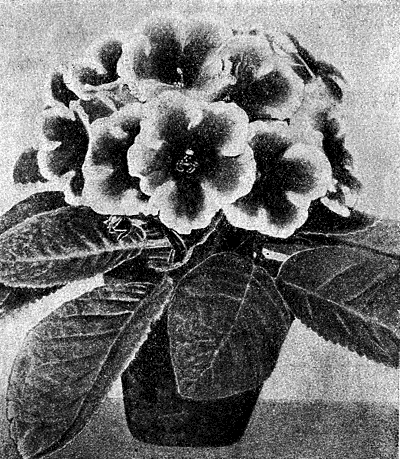
Rice. 164. Gloxinia
Reproduction: seeds, careful division of tubers, nodules, green and leafy cuttings. Sowing is done in February-March. After a double pick, the plants are planted on racks in a warm greenhouse or in the ground of a greenhouse. Watering each plant is done separately from the sock of the watering can. Gloxinia is rarely watered with clean water, and more often with fertilizer - first with a weaker solution, then everything is stronger. Plants are kept under the shade all the time and are often sprayed. Plants need not only repeated picking, but also repeated transplantation.
The land is given from a mixture of leaf, peat and turf with an admixture of sand and horn shavings. Strongly flowering specimens are obtained by July. Frequent transplanting and strong fertilization can produce a plant with very long flowering times. The closer to flowering, the more light you need to give, but flowering specimens at the very noon should be protected from bright light.
Plants from seedlings give healthier growth, bloom more abundantly, and suffer less disease than plants from tubers. For early flowering, small nodules from seedlings or leaves are stored in a dry room at 10-15 ° C in a dry fishing line. Since January, the nodules are germinated in a distribution box at 25 ° C and kept moist. After 3-4 decades, the plants develop so much that they are planted in separate pots.Before rooting, the temperature is maintained at 18-22 ° C, after rooting, it is lowered to 15-18 ° C. To avoid the appearance of thrips, they take care of humid air all the time. Frequent watering is required.
After flowering, pots with old tubers are stored on their sides in a dry room until March.
The group of Gesneriaceae, in addition to Gloxinia, includes - Achimenes, Columnea, Hegelia, Streptocarpus, Hybrid Tydea, etc. Tuberous Gesneriaceae have a dormant period, their tubers are stored in a dry warm room in winter. Gesneriaceae, which do not have tubers, remain always green. Gesneriaceae are cultivated in the same way as gloxinia, that is, in warm greenhouses, in stale air, with a constant shade, etc. The seeds give plants with more luxurious flowering than old tubers.
Tuberous include: achimenes, isoloma, tydea, etc.
Tuberless: Uzambara violet, streptocarpus, etc.
Calceolaria. Calceolaria hybrida. Slipper. Sem. Norichnikovs. Biennial plant in the form of low branchy bushes. There are dwarf varieties of C. hybrida nana - original two-lipped flowers; in color there are: one color scheme, painted - with a large spot on the lower lip, tiger or marble with spots of different colors and, finally, with stripes on the main background.
For autumn flowering, sowing is carried out in March, for spring - in July. When sowing, the seeds are not covered with earth, but only cover the bowls with glass. The seeds are as small as dust. It is better to propagate pure varieties at the end of summer by scions or cuttings, or in early spring - by herbaceous cuttings from young shoots. Planting in a mixture of leafy and turfy soil with sand. Calceolaria are delicate plants that require careful maintenance. They do not tolerate rain and wind. During the flowering period, they are used for indoor gardening. They overwinter at a temperature of 8-12 ° C.
Clivia (Olivia miniata and C. nobilis) (Fig. 165). Sem. Amaryllis. An unpretentious greenhouse plant that deserves a lot of attention. Leaves are linear, juicy green, beautifully curved. Flowers of various colors in large inflorescences - up to 20 flowers on one arrow. Long bloom. Reproduces by offspring. - A more sure way of reproduction is sowing. Seedlings bloom in the third year, offspring - in the second year. For faster development, clivia is cultivated on warm soil.
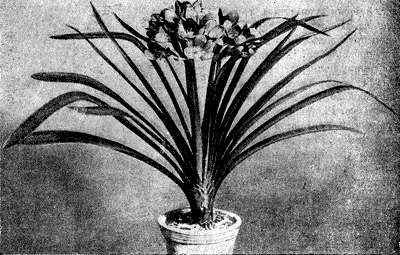
Rice. 165. Clivia
The land is given in a mixture of leaf, turf and sand. They are kept semi-dry before flowering. When transplanting, you must carefully handle the roots of the clivia. Large specimens are kept in tubs.
Lac-fiol (Cheiranthus Cheiri). Sem. Cruciferous. Yellow-violet. Perennial by nature plant with yellow golden, golden-brown with a purple tint, dark brown-red and other shades of velvety, fragrant, flowers, both simple and double. Simple flowers are no less beautiful than double flowers. Yellow-violet has a bushy form of high or dwarf growth. It is cultivated in the same way as winter or autumn levkoy. Compared to the latter, lacquer fiole is more durable. The best varieties for winter flowering are Dresden Lakfiol, Noev, Goliath, Ruprecht and Königsberg.
Lily of the valley (Convallaria majalis). Sem. Lily of the valley (Fig. 166). Well-known fragrant flowers. In culture - mainly Dutch and German garden varieties. (C. m. Berolinensis). Forest lilies of the valley recommended by some for distillation do not give good results. Blooming lilies of the valley can be kept all year round. Blooming lilies of the valley in winter is achieved by forcing at a relatively high temperature.

Rice. 166. Basket with blooming lilies of the valley
There are two distillations: early - before the new year and late (at a lower temperature) - after the new year. After January, strongly developing greens have to be cut off. For summer distillation, lilies of the valley are artificially delayed in development by storing them at low temperatures - in ice or in refrigerators.
Before the plants go to forcing, preliminary preparation is required, lasting for three years.Lilies of the valley are perennial herbaceous plants with creeping rhizomes. Lilies of the valley reproduce by buds protruding from underground stems, that is, rhizomes - in the form of sprouts (Fig. 167). Actually, these sprouts go into distillation. Annual shoots bloom only in the third year after their formation, two-year-olds bloom in the second year, and three-year-old shoots in the same year. One-year-old sprouts have a sharp top (Fig. 168), two-year-olds are already more rounded, and three-year-olds (already flower sprouts) have an even more blunt top with a slight swelling (the rudiment of future flowers). Digging of lilies of the valley from the ridges is carried out in the fall. The earth, moved from its place with a shovel, is lifted with an iron pitchfork and the earth is shaken off from the rhizomes.

Rice. 167. Lily of the Valley Sprout Requiring Two Years of Culture
The sprouts selected from the ground are sorted into three groups: 1) fully ripe lilies of the valley, suitable for distillation, 2) weak three-year-old two-year-olds, and 3) weak two-year-olds and one-year-olds. Each group is planted in separate areas. Lilies of the valley are planted either in low beds or without ridges in a damp place. Planting on level ground without ridges is preferable, since in this case mechanization of production processes is possible. Loose, sandy-soddy soil is most suitable. Fertilization of plantations is carried out with decomposed humus or mineral fertilizers.
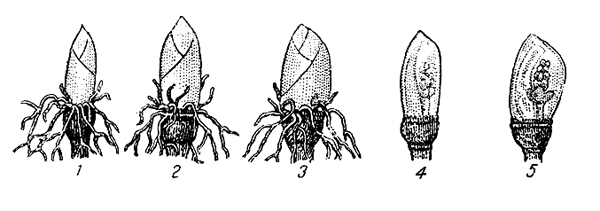
Rice. 168. Lily of the valley sprouts in different stages of development: 1 - the second analysis, 2 - the first analysis, 3 - with premature flowering, 4 and 5 - longitudinal sections through the shoots (2 and 3)
Plantation care consists in a shelf, loosening, shading, watering in dry weather, in a shelter for the winter with leaves from frost. Lilies of the valley fit for the race are buried in (Fig. 169), and immature ones are sorted and planted again in the ground for further development.
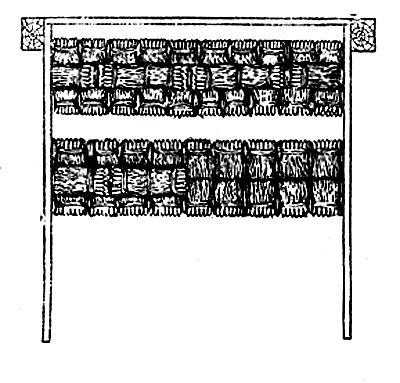
Rice. 169. Digging of lilies of the valley
Plants that have sat for three years in a garden bed, with a thick blunt-pointed bud, give a strong flowering when distilled. Also, the sprouts, tied in bunches, are kept dug in the open air, taking out as needed for planting. Before planting, for better germination. rhizomes are frozen in refrigerators (glaciers) for 5-6 hours or in the open air during the day in the snow.
Planting, if it is possible to freeze the rhizomes, begins in the second half of October, repeating it, if desired, every ten days. The rhizomes are placed in pots or baskets, laid on their side so that the buds at the tops of the rhizome are at the same level. Pots (Fig. 170) or baskets covered with moss are kept for 8-12 days in racing boxes at a temperature of 30 ° C, in the dark and always in a moderately damp state; the latter is achieved by watering with warm water at 25-30 ° C. When the flower arrows are drawn off, the shade is removed. To prevent the plants from stretching too much, they must be kept closer to the light.
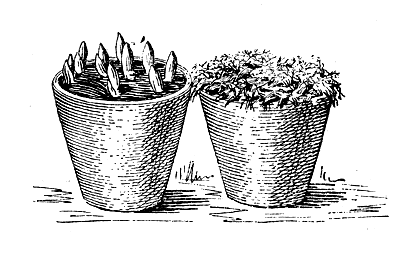
Rice. 170. Culture of lilies of the valley: on the left - freshly planted sprouts of lilies of the valley, on the right - the same pot with sprouts, covered with moss
Early forcing lasts about a month, and late forcing in summer is no more than a decade and a half. From December, forcing is easier and easier. When forcing lilies of the valley, instead of freezing, they resort to warm baths, for 12-16 hours at a temperature of 32-35 ° C.
For a longer flowering period, lilies of the valley with completely blossoming flowers are kept at a temperature of 10-12 ° C.
Figure 171 shows how to prune the roots of lilies of the valley before planting. It must be borne in mind that after planting, the lily of the valley does not develop new roots, but absorbs moisture, mainly through the cuts in the roots.
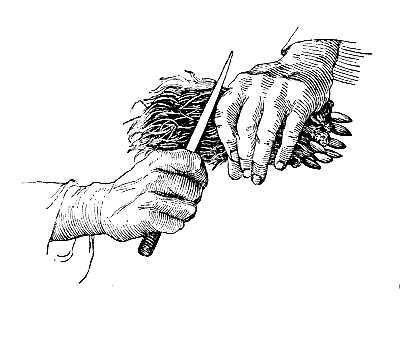
Rice. 171. Pruning lily of the valley roots
There are varieties of lilies of the valley with pink and double flowers, with pedicels branched in the brush.
Lilies of the valley, especially the large-flowered variety C. majalis major, certainly deserve a lot of attention for indoor gardening.
Winter Levkoy (Cheiranthus ineana-Mafttiola). Sem. Cruciferous. One of my favorite flowers, plants, beautiful in the form of their fragrant flowers. When sown in April, the plants bloom in March-April-May of the next year.Sowing is carried out in the soil of the greenhouse. The seeds are not covered, but as they germinate, they are covered with fine sifted soil. Sowing is done rarely in order to avoid a pick before landing in the ground. The land is given as clay-sod; does not tolerate fresh humus with levkoy.
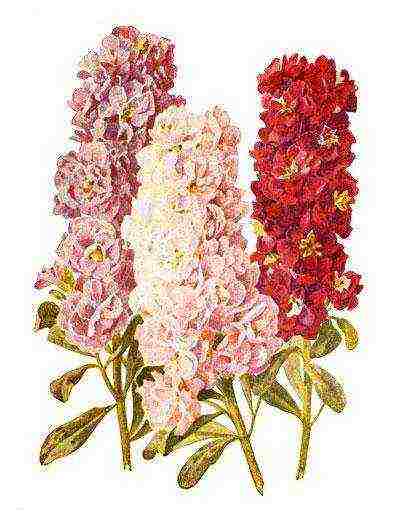
Levkoy "Perfexion" (Matthiola annua)
Care consists mainly of watering, but excessive moisture should not be allowed leading to plant disease (black leg). Greenhouses should be ventilated and, if weather permits, kept open. Greenhouses should be closed in rainy weather. For plants to harden well, they need to be given as much air as possible.
At the end of May, well-hardened plants, not afraid of matinees, are planted in open air beds at a distance of 30 cm from one another. The less often the planting is done, the more air the plants will have and the less they will hurt. Care at this time consists in a shelf, loosening and watering, as needed. Premature flowering buds are plucked out.
In late August - early September, the plants are removed from the ground and planted in pots. For rooting, they are kept under frames in cold greenhouses. After ten days, the greenhouses begin to ventilate, accustoming the plants to the air. In deep greenhouses, plants can be kept until December, protecting the greenhouses from frost by covering with frames; there are many chrysanthemums in greenhouses at this time, and there may not be free space. The yellowed leaves are not torn off, but cut off. The same is done with the shoots to be removed. The frames are disinfected.
For the winter, the plants are brought into a dry greenhouse with a temperature not exceeding 5-6 ° C. The greenhouses must be well ventilated, and the plants should be watered moderately (keep them semi-dry). To prevent the plants from rotting, they do not water the pots themselves, but the sand on which they are installed. The pots should not be moved from place to place, as the levkoy receives nutrition through the roots that penetrate into the rack soil.
Sometimes Levkoi infects Fusarium, which leads to the death of 100% of the plants. When black spots appear on the branches, the latter must be cut off, sprinkle with crushed coal, otherwise the affected plants will inevitably die. Liming and disinfection of the soil, dressing of seeds and fruit change are preventive measures against this disease.
Particular attention should be paid to the good quality of the seeds. Sowing should be done with seeds that give terry plant varieties. The main varieties of winter levkoy are: White Lady, Elizabeth and Elberfeld. Figure 172 shows a soil culture of Levkoy in a greenhouse.
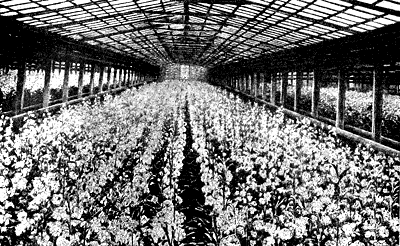
Rice. 172. Levkoy soil culture in the greenhouse
Mimulus (Fig. 173). Lipstick. Sem. Norichnikovs. Beautiful plants for pot culture. Flowers are tubular, with a two-lipped limb. Blooms in June - October.
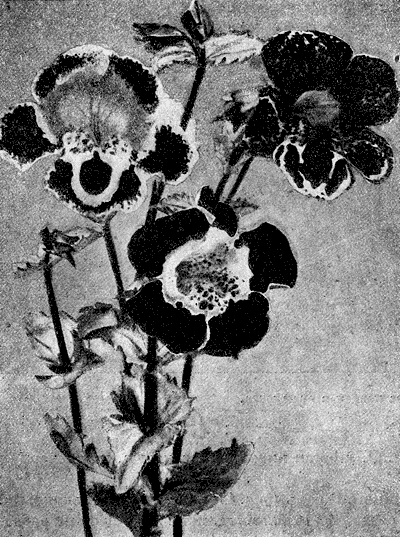
Rice. 173. Lipstick (Mimulus)
Varieties: crimson - M. cardinalis (45 cm), with a musky scent of greenery: - M. moschatus (15 cm), with variegated flowers - M. tigrinus (30 cm). The seeds are very small, they are not planted during sowing. Sowing in March. Seedlings should be kept dry.
M. moschatus is good for indoor keeping.
Ophiopogon. Ophiopogon. Sem. Krovennikovs. An unpretentious greenhouse plant with variegated linear leaves and erect arrows bearing white and purple flowers, and later blue berries. Reproduction by division in the spring when transplanting. The best species of O. spicatus with leaves up to 1 m in length. O. jaburan has dark green, almost black foliage.
Pelargonium (Pelargonium). Geranium (fig. 174). Sem. Zhuravelnikovs. Greenhouse plants with succulent stems and leaves, flowers of various colors in umbrellas.
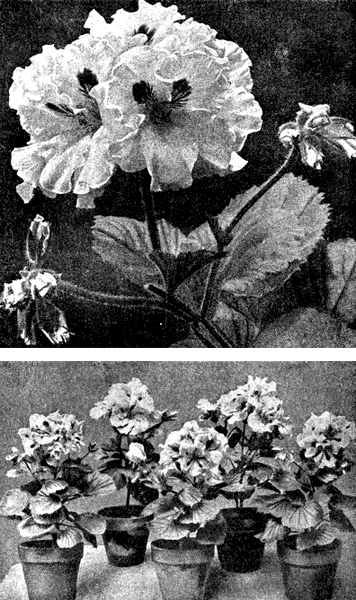
Rice. 174. Pelargonium
There are three groups of pelargoniums: 1) zonal (P. zonale), 2) ivy or creeping (P. peltatum) and 3) English large-flowered (P. grandiflorum).
P. zonale. They form a group of zonal variegated pelargoniums, with white and dark borders on the leaves. Zonal pelargoniums are subdivided into dwarf variegated varieties for cleaning carpet beds and vigorous large-flowered varieties for indoor gardening.
The reproduction of dwarf pelargoniums has already been discussed in the section of carpet-mosaic plants. When cultivating zonal pelargoniums for indoor gardening, in order to get large-growing specimens, they resort to pinching the main stem and transplanting plants from 9- to 13-centimeter (from 2- to 3-vert.) Pots.From zonal pelargoniums for rooms there are varieties: Meteor, Ada, Reformer, etc. Among them there are both double forms and forms with fragrant flowers.
P. peltatum. The culture of ivy or creeping pelargonium is no different from the culture of zonal, only they require a garter. When cuttings in February-March, bloom in July. Three or more pegs are placed in pots with these pelargoniums, along which the plants are untied, obtaining flowering pyramids. P. peltatum has creeping, faceted stems with ivy-shaped leaves, with white and pink flowers in umbrellas on long: pedicels. They are good for vases, balcony boxes and for obtaining standard forms.
The best types: M-ss Bouks - white, gardens Glory - scarlet terry, Roland - raspberry semi-double, etc.
P. grandiflora is an English large-flowered pelargonium. They are used for indoor landscaping, as well as for decorating verandas, balconies, outside window sills, etc. English pelargoniums are an outstanding decoration for rooms in comparison with more modest zonal pelargoniums.
Distinguish between summer and spring breeding of English pelargoniums. Summer propagation by cuttings is carried out in June - August. For pelargoniums, it is necessary to have good compost soil prepared in advance. To ensure the production of beautiful and abundantly flowering plants, the land must be heavily fertilized with mineral and organic fertilizers.
In summer breeding, planting is carried out in 6-7 cm (1.5 vert.) Pots in a mixture of turf and sand. Plant pots are placed in a semi-warm greenhouse, away from glass. For the plants to take root successfully, it is necessary to apply spraying.
For spring cuttings, planting is carried out directly on the shelves of the exploration greenhouse or in cuttings boxes. Summer cuttings are preferred, since in April-May of next year, strong flowering plants are already obtained.
After rooting, transplantation is carried out into several large pots. To grow a bush, pinch the main shoot. Until the fall, they keep them in greenhouses all the time. Before freezing, they are brought into light greenhouses with a temperature of 6-8 ° C and placed on racks closer to the light. Moderate watering is performed. It is necessary to fumigate the plants, as they are often and strongly attacked by green aphids.
With the onset of sunny spring days, the temperature of the greenhouse is raised; plants are sprayed. By the first of May, pelargoniums bloom. The absence or weakness of flowering indicates poor nutrition. Faded plants are stored in winter at a temperature not exceeding 5-6 ° C. In the spring - transplant. The rest of the care is normal.
The best are the pelargoniums obtained by the German hybridizers Burger and Fays (early-flowering remontant varieties). The most famous are: My Ideal, Balcony Queen, M. Sanders, etc.
Cross-pollination of English pelargoniums with ivy-like hybrids produced hybrids that promise to take the place of zonal ones in the ground and for indoor gardening.
Pelargoniums are unpretentious indoor flowering plants, and zone and ivy pelargoniums are also among the best plants for decorating balconies and window boxes. Pelargoniums are planted directly in the ground of the box or dipped in a box in pots. Pelargonium thrives best on south-facing balconies.
Primula (Primula). Sem. Primroses. Beautiful plants blooming for almost a whole year with short interruptions. Flowers in pure colors - red, pink, blue and white.
The best varieties belong to the hybrid Berlin, Hamburg and Arendsii group. In culture, only large-flowered varieties P. obconica grandiflora gigantea.
Another type of greenhouse primrose is the primrose P. chinensis (Chinese primrose) (Fig. 175), it blooms less abundantly than the obkonika. P. ch. fimbriata is a brilliant orange-flowered variety with fringed edges.
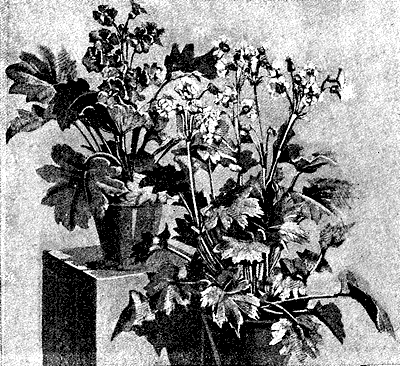
Rice. 175. Primula Hinensis
P. malocoides (fig. 176) blooms in the fourth month of sowing.

Rice. 176. Primula Malakoides
Simple primroses are propagated by seeds, terry primroses are propagated by cuttings.For autumn flowering, sowing is carried out in January, and in order to have blooming primroses until April next year, sowing is repeated in March-April. Sowing is done in boxes with light soil. Small seeds are either not sprinkled at all or are sprinkled only slightly. The boxes are kept under glass. The crops are shaded from the sun. The earth is kept moist. As soon as the seedlings have one leaf at a time (not counting the cotyledons), they are dived into boxes in a mixture of leaf and greenhouse soil at a distance of 1 - 2 cm from each other. With early sowing, the plants remain in the greenhouse, with late sowing, they are placed in the greenhouse.
Care consists in moderate moisture, airing, and, if necessary, in a light shade. Plants are given necessarily two, and sometimes three picks. The developed plants are planted in 6-7-centimeter (1.5 vers.) Pots, of which they are transferred into 10-11-centimeter pots, in which they go on sale. For reproduction by layering, the base of the plant stems is covered with wet moss. After the roots appear, the stems are cut off and planted as independent plants. This method of propagation of primroses for inexperienced cultivators is more reliable than cuttings.
One of the serious moments of summer primrose care is the shade, which is achieved by covering the greenhouse frames with shields or whitewashing the glass frames with a lime mortar. Covering frames with clay is undesirable, since the clay heats up a lot and transfers heat to the inside of the greenhouse, while primroses do not tolerate excessive heat. It is better to install primroses to use greenhouses, stuffed finely so that the plants are as far away from the frames as possible.
With the onset of cold weather and even in August, primroses are brought into a greenhouse with a temperature of about 10 ° C and placed closer to the light. For more abundant flowering in autumn and winter, pedicels that appear in summer until July are plucked out, or plucked at least until strong bushes develop, since flowering weakens growth. All autumn primrose can be realized from greenhouses, without removing it from the greenhouse, as it blooms well in greenhouses, as gardeners say.
If the plants were cut directly into the greenhouse soil, then they are planted in pots in the second half of July or early August.
The culture of primrose hinensis differs from the just described culture of primrose obkonik in that, due to fragility, primrose hinensis is grown in pots without planting in the soil of a greenhouse. Chinese primroses have a weaker growth than obkonika, they easily stretch and fall apart. Therefore, they need to be given less shade and more air, as well as to be spaciously installed, keep it cooler in winter {6-7 ° C).
Terry primroses are propagated by layering and cuttings. For propagation by cuttings, flower arrows are cut off from faded primroses, and the plants are placed in an exploratory greenhouse. Lateral processes go to the cuttings. Cuttings are made from March to June several times, for which the newly emerging offspring of mother plants are used. Cuttings are rooted in a greenhouse exploration box, planted in coarse sand. The box must be covered with glass, otherwise the cuttings may wither. With the formation of callus on the cuttings, the plants begin to air.
In the sun, to prevent wilting, shading and spraying are done. Rooted cuttings are planted in pots, which are placed in a warm greenhouse. As the roots entwine the earthy coma, the plants receive transshipment.
The land is given in a mixture of leaf, turf and greenhouse humus with the addition of horn sawdust or pigeon droppings. Sometimes peat humus is added. Primroses are great plants for indoor landscaping. On a cool sunny window, with a uniform humidity of an earthen coma, primroses bloom all winter. In the spring - transplant.
Reseda (Reseda odorata). Sem. Resedovs. Commonly known plant - small fragrant flowers in pyramidal spikelets. The best varieties include: Machet - undersized, with dark green leaves and dark brushes of reddish flowers, Victoria - dark brown, Noah, Goliath, etc.
Propagated by seeds. For winter and early spring flowering, sowing of mignonette begins from mid-July. Seedlings dive into boxes or greenhouse soil. Great care should be taken during this operation, since mignonette is extremely fragile.
At first, the plants are kept in stale air; when they get stronger, they are accustomed to fresh air. On sunny days, a shade is necessary.
The second pick is made in pots: 6-7-centimeter (1.5 vert.) 1 piece or 9-centimeter (2 vert.) 3 pieces each.
Reseda is given a weak planting, that is, the earth is not strongly pressed to the roots. When cold weather sets in, pots with mignonette are selected from greenhouses and placed in a cold greenhouse on shelves closer to the light, but at such a distance from the glass that the tops of the plants cannot freeze. A layer of sand 2-3 cm thick is poured under the pots on the shelves so that the bottom of the pots is immersed in the sand. The temperature should not be higher than 3-4 ° C, otherwise the mignonette stretches and falls. The temperature is best at which the plant stops growing.
Watering is given rare and weak (if only the plants do not wither); Excessive watering leads to leaf curling, root rot and plant death. To maintain moisture, it is enough to water the sand between the pots. It is impossible to rearrange or move plants from place to place before growth begins. This entails damage to the roots that have passed through the hole in the pot into the sand: it is enough to turn or raise the pot to kill the plant.
When transplanting the plant, it is necessary to put it in order, that is, to tie it up, pick off withered leaves, loosen the ground, wipe the pots and proceed to regular watering. The retracted shoots must be pinched, bearing in mind, however, that the lateral shoots give weaker inflorescences. Therefore, in order to avoid pinching, plants are planted when diving in 4-5 pieces in one pot. At the beginning of growth, the temperature is raised to 10-15 ° C.
Reseda land is given in a mixture: turf 1 part, leaf 1 part, greenhouse 1 part and river sand 1 part. When transferring, it is useful to add horn shavings, pigeon droppings, etc. It is very useful to lubricate the inner walls of the pots with cow dung.

Perennial Japanese chrysanthemums (for flower beds)
Chrysanthemums (Chrysanthemum) (Fig. 177). Sem. Compositae. Chrysanthemums are native to China and Japan. Irreplaceable flowering plants for the fall and winter seasons - on sale from August to January.
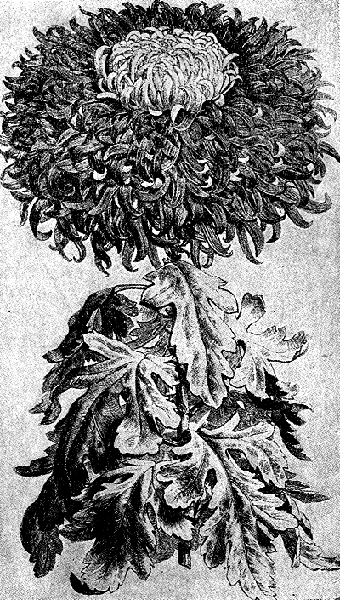
Rice. 177. Chrysanthemum
Of the forms of chrysanthemums, the most famous are: large-flowered standard (Fig. 178, 179), large-flowered bush (Fig. 180), small-flowered bush (Fig. 181), weeping or cascading (Fig. 182) with double and non-double (simple) flowers. Among the large-flowered varieties are known with hanging petals, needle-like, tubular, shaggy, concave, etc. Flowers are found in various colors: white, pink, yellow, bronze-golden, etc. In the culture of individual varieties of chrysanthemums have their own characteristics.
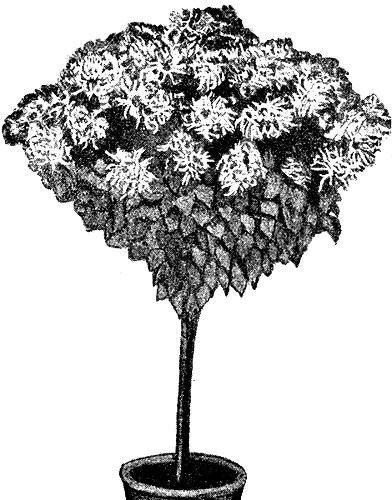
Rice. 178. Large-flowered standard chrysanthemums
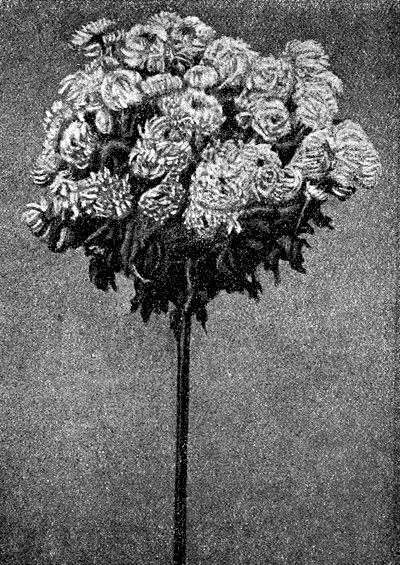
Rice. 179. Large-flowered standard chrysanthemums
Culture of large-flowered chrysanthemums. Large-flowered chrysanthemums reproduce exclusively by cuttings. Only the healthiest and strongest specimens should be taken on the mother liquor. Chrysanthemum mothers are stored buried on shelves, without pots, in a greenhouse with a temperature of 5-7 ° C. Mothers are placed on the shelves tightly lumped to a coma, and the spaces between the comas are covered with earth. When stored in the dark, the shoots stretch out and die. Watering is done carefully, avoiding only wilting, since flooded plants do not produce good cuttings.
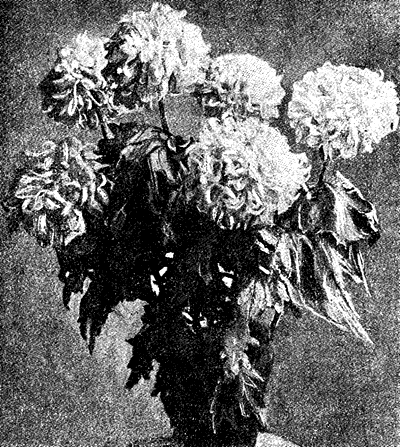
Rice. 180. Large-flowered bush chrysanthemums
Cuttings start from January-February, for early varieties - later, for late ones - a little earlier. When propagated before January, cuttings do not give callus and disappear. Only the tops of the processes emerging from the ground are taken for cuttings. The shoots of the old stem should not be taken on cuttings. Cuttings are cut with a sharp knife so as not to crush their ends.Otherwise, the cuttings will rot and disappear. Reproduction of chrysanthemums is done by green cuttings - usually they are cut close under the knot, and some practitioners - a little further. Cuttings are planted in a mixture of old compost soil and sand. This mixture is poured onto racks and covered with a layer of clean, washed sand 2-3 cm thick. Rooting occurs at a temperature of 12-15 ° C, after about two decades.
Rooted cuttings with early cuttings are planted in picking boxes. With a somewhat late cuttings, when there are already semi-warm greenhouses, the cuttings are planted in 6-7 cm (1.5 vert.) Pots and kept in these greenhouses under the frames, that is, under conditions of stale air. As soon as the plants take root and start growing, they begin to accustom them to fresh air by raising the frames. On sunny days, spray 1-2 times. After the plexus of the coma with the roots of the plants, they are transplanted into a large bowl, preventing growth stoppage, since otherwise the plants will grow stiff, develop poorly and bloom poorly. The transfer is repeated 1-2 times.
On warm days, the frames are removed from the greenhouses, and when warm weather sets in, the pots with plants are put out of the greenhouses on the ridges, where the chrysanthemums are in an open sunny place before the onset of cold weather. Large-flowered chrysanthemums are grown in pots all summer.
Care consists in a shelf, loosening and fertilizing with a solution of nitrate. When transferring, it is useful to add soot and coal powder, which retain ammonia, as well as bone meal, horny sawdust. Before the onset of matinees, the plants are placed in greenhouses or on the shelves of greenhouses, closer to the light. This is where chrysanthemums begin to bloom. If the plants have large buds and the first flowers have appeared, then they begin cleaning under glass earlier, since the flowers rot from rain or dew. This harvest is common for early varieties. Harvesting of late varieties is carried out selectively: first of all, plants with large buds are removed, and plants with small buds are kept on the ridges and harvested closer to cold weather.
Sometimes they resort to setting up a canopy over the plants from greenhouse frames fixed on stakes. Under such awnings, you can get clean and better developed flowers.
When cut in March (eg Qn. Mary), chrysanthemums bloom in September. If the culture is carried out for a late cut, then the plants are planted not in pots, but in the soil of the greenhouse.
In the culture of chrysanthemums, pruning is of great importance. For large-flowered chrysanthemums, pinching or plucking of axillary buds is used to prevent lateral shoots from developing. It turns out a plant in one stem, ending in one very large flower.
Some varieties of Japanese chrysanthemums, for example, red Tokyo, in which the reverse side of the flower petals is silvery, can be obtained with 2-3-4 equally large blooming flowers at the same time. For this, cuttings are allowed to develop two, less often three of the strongest shoots. As for all other axillary buds, they are removed as they appear during the entire period of preparation of the plant for flowering. Often, 2 or 3 buds suddenly appear at the top. In this case, the strongest bud is left, and the rest are carefully removed. Removal of these buds, even if the stem is slightly damaged, leads to a curvature of the bud left. Timely plucking of axillary buds is an indispensable condition for the culture of Japanese chrysanthemums, since this technique gives not only correct and large flowers, but also accelerates the onset of flowering dates.
The culture of bush small-flowered chrysanthemums differs from the culture of large-flowered ones in that small-flowered chrysanthemums are planted from pots without transferring directly to the ridges. Cuttings of these chrysanthemums cut into boxes are also planted directly into the ground at a distance of 50-60 cm from one another. With a denser planting, the danger of diseases increases, the plants lose their foliage and turn out to be bare. Ordinary planting makes it possible to mechanize the care of chrysanthemums. A tape two-line planting is also recommended.
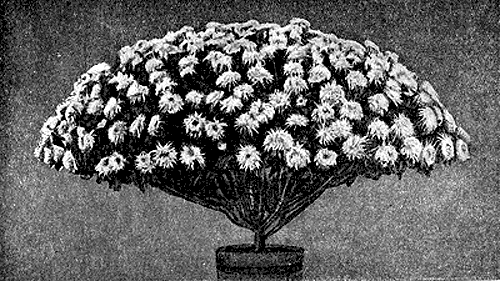
Rice. 181. Small-flowered bush chrysanthemums
Plants are transplanted from soil into pots from the end of July until cold weather. The transplanted plants are initially kept in greenhouses or directly transferred to a greenhouse.
One of the main methods of the culture of small-flowered chrysanthemums is the formation of plant bushes. It is produced as follows. When, before planting in the ground, the plant develops 4-5 leaves, pinch its top. After the first pinching, 2-3-4 shoots appear. At the end of June, when the shoots already have 7-8 or more leaves, a secondary pinching is performed, in which only the very tip of the shoots is pinched off. After the second pinching, new shoots appear from the axils of almost every leaf. Thus, a plant bush is formed, which gives from 20 to 40 or even more fully developed flowers.
Small-flowered varieties of chrysanthemums can be grown in standard forms, removing side shoots to the intended height of the stem. The top of the stem is pinched, causing its bushiness. By repeating the pinching of the tops of new shoots 2-3 times, a well-developed crown is obtained. Weeping forms of small-colored chrysanthemums look even more decorative. The soil for chrysanthemums is made up of a mixture of 2 parts of turf and 1 part of humus. Horn shavings and pigeon droppings are added to the mixture. The use of these fertilizers helps to obtain larger and brighter flowers and more foliage of plants with beautiful dark greens.
Chrysanthemums are susceptible to many fungal diseases, of which the following are the most dangerous:
Black spot. With a disease, brown spots appear on the leaves of plants; the affected leaves fall off prematurely. The spores of the fungus are carried by the wind from plant to plant.
Gray rot. The stems of diseased plants are covered with a gray bloom, which passes over to the flowers. The disease leads plants to oppression and death.
Downy mildew. On the leaves of diseased plants, whitish powdery mildew appears on both sides.
The emergence and development of these diseases is greatly facilitated by the wrong culture of chrysanthemums: excessive moisture, stale air, etc.
Control measures: spraying with Bordeaux liquid, collecting and destroying diseased leaves (for more details, see chapter "Plant Protection").
Among bacterial diseases, a relatively rare lesion of chrysanthemums with cancer can be noted. This disease manifests itself as growths on the stems and roots. When such growths appear, diseased plants must be burned.
Chrysanthemum pests from the insect world include leaf aphids and thrips. But the most dangerous pests of chrysanthemums are nematodes, against which no radical remedies have yet been found.
Of the diseases associated with the wrong culture of chrysanthemums, it is necessary to point out the rotting of the buds. In greenhouses, where rotting of buds is noticed, it is necessary to produce increased ventilation, leaving the vents open at night and slightly heating the room in order to reduce the humidity of the air. For the same purposes, chrysanthemums are cultivated mainly in greenhouses with overhead heating.
Of the best industrial varieties of large-flowered chrysanthemums, it is necessary to indicate: Qn. Mary - pure white flowers; Lioneti - apricot yellow flowers.
The most famous of the early varieties are: Rayonnant — pink needle-like; Fulling - flowers with an intense yellow-golden color; M. Gustav Henry - white - one of the earliest cultivars reliable in the culture.
Of the mid-early varieties, we note: Mss. S. Drable - creamy white: M. Draps Dom - pink flowers; Sax. Export - soft pink with a slight purple tint.
Late: M-me Rene Oberthur - white; Dolyphrenn - pure yellow Russo is a lilac-pink color.
In addition to the listed most common varieties, the following are known: E. I. Brooks — a mid-early variety, the flower petals are dark red on the inside and silvery on the outside; Lirnone - matte yellow M. Toulna - golden bronze; Soleil d'Octobre - canary yellow Mille is brown.
Of the varieties of small-flowered chrysanthemums, we indicate: Schneeteppicli - white, there is a form (sport) with yellow flowers; Parisienne - white with a pink tint Miss Selley - silvery pink F. K. Grusson - bronze and MM Masse - rose red.
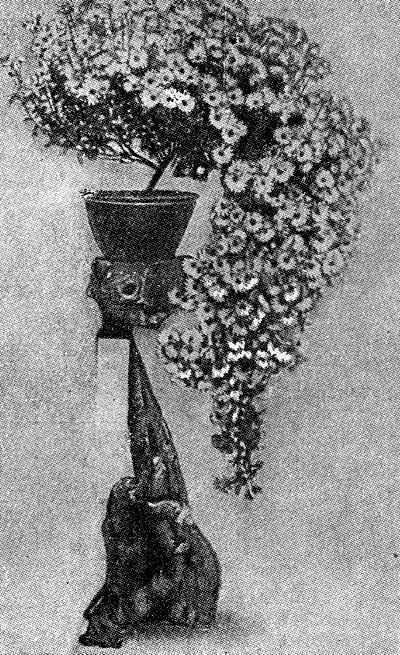
Rice. 182. Weeping Chrysanthemum
Cyclamen (Cyclamen persicum). Sem. Primroses (fig. 183). A greenhouse plant, it has a hard fleshy tuber and long petiolate, kidney-shaped leaves. The color of the leaves is cloudy. Flowers of white, pink, purple, crimson and red colors.
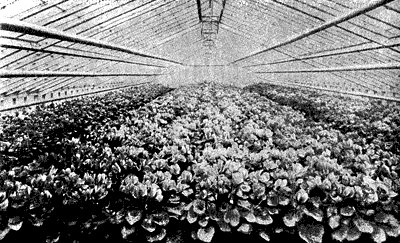
Rice. 183. Cyclamen culture in the greenhouse
The best varieties: S. p. magnificum, splendens, sanguineum, fantasia (rococo) (Fig. 184), etc.
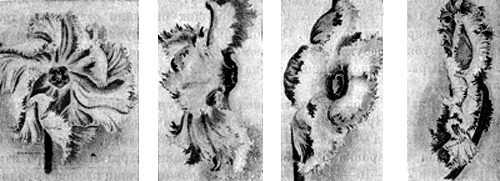
Rice. 184. Cyclamen Flowers "Fantasy"
Cyclamen blooms in greenhouses and rooms from October to March. It is considered one of the most grateful plants for winter flowering. Propagated only by seeds obtained as a result of artificial pollination. Large-colored plant specimens are chosen for seeds. Sowing in bowls is done in July-August. At a temperature of about 12-15 ° C, the seeds germinate in a month, and the seedlings in September-October are already ready for the first pick into the boxes. The seedlings are kept in a greenhouse at the same temperature, gently sprinkling them 2-3 times on clear days. As needed, produce a shelf with loosening. After the development of the third leaf, the seedlings dive a second time. The temperature of the greenhouse with wintering seedlings should not be higher than 10-12 ° C.
In April-March, seedlings are planted in 4-5-6-centimeter pots. The land is a mixture of turf, peat and leaf with an admixture of sand. With the onset of heat, the pots are transferred to greenhouses with a temperature of 20 ° C and above. To protect the plants from root burns, a layer of light humus earth or sawdust is poured onto the hot manure of the greenhouse (the latter are better for letting heat through) and pots are placed on it. When picking, the tubers are planted shallow in the ground. If the tubers are planted to an excessive depth, then the bases of the petioles pamper and the leaves fall off.
If planted too shallow, the tubers turn wood and discard the buds prematurely. Only on the last transplant should 1/3 of the tuber be placed above ground level.
Plant care consists of a shelf, loosening, airing, spraying, careful watering and shading with shields. During the summer, two, less often three transshipments are carried out, depending on the development of tubers. After each transshipment, the greenhouse is interrupted to maintain the temperature. The initial landing is in the above light ground. With each transplant, the amount of sod land increases, and it should prevail during the last transplant.
In early autumn, frames are removed from the greenhouses at night to harden the plants. In September-October, the plants are brought into a greenhouse with a temperature of 8-10 ° C and placed on racks closer to the light. Good ventilation is required.
Plants should be kept at a low temperature until the full development of the buds. If this rule is violated, the flowers are deformed, the pedicels twist, the plants rot. Watering is done from the edge of the pot, otherwise the buds may rot. In November-December, and sometimes earlier, the plants will already be in full bloom.
Pots with old tubers of faded plants are placed in a dry place and watering is stopped. In the spring, when replanting, fresh soil is needed. Old tubers require the same growing and care practices as young ones. Growing cyclamen from old tubers gives poorer results.
In Germany, experiments were carried out on the culture of cyclamen in a short time. When sown in mid-November, the plants were in bloom in late September - early October of the following year. A double pick was used in early December and late March and a three-time transfer in 7-8-10-11 and 13-14 cm pots in late April, early June and early August. Small varieties of cyclamen, when sown on March 31, were in full bloom by the new year.
It should be noted and successful experiments of cyclamen culture in greenhouses without interruption.For plants, conditions were created in which they grow at home; During the day they were kept with closed frames, providing maximum heating, and at night the greenhouses were left open, and the plants were exposed to low temperatures until morning. Under these conditions, seedlings of the first year had nodules up to 3 cm in diameter, and in autumn or winter the plants gave up to 30-40 flowers.
Cyclamens do not tolerate concentrated, organic or mineral fertilizers. Lime water is completely unsuitable for watering.
When cultivating cyclamen, it must be borne in mind that an excess of nitrogenous fertilizers causes rotting of tubers. Damage to tubers also leads to rotting. With an insufficient size of pots and woody tuber, premature and very weak flowering of plants is observed.
Plants are attacked by thrips and leaf aphids, against which fumigation is applied. It is also necessary to destroy the caterpillars of the gray moth.
Cyclamens are best purchased in floricultures in the fall, not earlier than October, choosing specimens with low-lying leaves, under which a large supply of buds is noticeable. A good flowering of cyclamen requires a lot of light and a cool plant content. When watering, water should not come into contact with the tuber. Careless watering causes rotting of flower and leaf petioles.
Alpine cyclamens - C. europeum with numerous small flowers of pleasant smell are less demanding in indoor conditions.
Cineraria (Cineraria liybrida). Sem. Compositae (Fig. 185). Beautiful winter flowering potted plants. They have many high, medium and low varieties with small, large and very large double, semi-double and simple flowers of the most diverse (except yellow) color. The most famous varieties include the large-flowered cineraria - Matador - with bright scarlet-red flowers. Good S. b. azurea with blue or azure blue flowers, and other forms of hybrid cineraria in its various colors.

Rice. 185. Cineraria
Cineraria reproduce mainly by seeds. It takes 7-8 months from sowing to flowering. Sowing for late winter and early spring flowering is carried out from July. To have blooming cineraria in winter and spring, sowing is repeated 2-3 times in two decades. Small seeds of cineraria do not fall asleep, but only tightly cover the crops with glass. When leaves appear, seedlings dive into boxes. After the second pick, plants with well-developed leaves are planted in 9-centimeter pots, which are placed in cold greenhouses for the summer.
Care consists of watering, light spraying on clear days, shelf, loosening and shading, especially in summer during the heat. With the onset of cold weather, the plants are brought into a greenhouse with a temperature of 4-6 ° C and placed on racks. In the spring, before the start of growth, the plants are transshipped into 13-centimeter pots. In case of untimely transshipment, the plants throw out the arrow.
For cineraria, nutritious clay-sod land is needed with an admixture of good humus and fertilizers (horn shavings, etc.). Only with timely transplantation and sufficient fertilization can you get well-developed plants (from 10 to 12 pieces per square meter of greenhouse).
Of the fungal diseases for cineraria, the black leg is dangerous. With this disease, the stems turn brown, break, the plants lodge. Of insect pests, leaf aphids attack cineraria.
BULBS
Bulbous plants occupy a very large place among flowering plants. Many of them are suitable for winter forcing. Ripe bulbs with flower buds are usually produced in August-September. Distillation is carried out in pots or glass containers with water.
The best bulbous plants include the following:
Amaryllis (Amaryllis). Sem. Amaryllis (Fig. 186). Very valuable for indoor gardening beautiful bulbous plants with linear-lingual leaves and single or collected umbrella on a bare fistula lily flowers. Small-flowered amaryllis have 6 or more flowers on the arrow, large-flowered - 2-4 flowers.The main color of the flowers is dark red and soft pink. Flowering begins in the second half of winter.
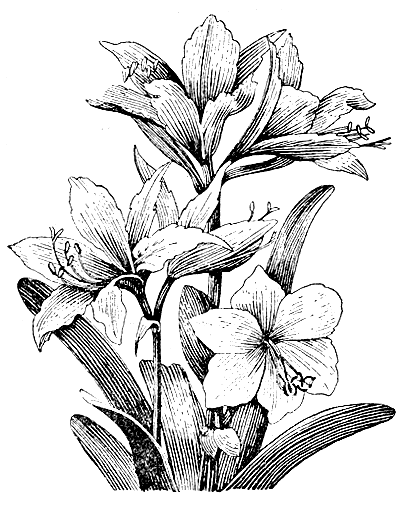
Rice. 186. Amaryllis
Botanists refer to amaryllis only A. Belladonna with a flower arrow bearing 8-12 bell-funnel-shaped flowers of a delicate pleasant smell. Gardeners classify Sprekelia formosissima, Hippeastrum and some species from the genus Nerine, Vallota, Sternbergia, etc. as Amaryllis.
Amaryllis in the first half of winter are most often dormant. Storing them during this period in boxes, as is sometimes recommended, is unacceptable, since the roots deteriorate during such storage. Plants should be stored in the same pots in which they were before the dormant period.
Technically, the culture of the Amaryllis is quite complex. In the north, they are grown in gable warm greenhouses under frames, without any tint, with increased watering and spraying.
Reproduction is carried out by seeds (January-February) and bulb babies. The cut seedlings are planted in pots at the end of May. The earth is a mixture of turf and leaf with the addition of sand. Until the end of summer, the plants are kept in a semi-warm greenhouse. For the winter, they are placed in a greenhouse with a temperature of about 10 ° C. In the spring, the plants are transplanted into several large pots and placed in a greenhouse.
In the second year, in addition to the usual care, plants are given fertilizing watering. At the age of three, most amaryllis are already blooming. After flowering, a transplant is performed annually. With her, onion babies are separated, which easily take root. Amaryllis should not be transplanted into large pots. During transplantation, root injury is unacceptable.
In the conditions of the north and middle zone of the Union, it is hardly advisable to cultivate amaryllis. Their culture is best done in the south, for example, on the Black Sea coast, where amaryllis bloom on open ridges for the second year.
A feature of amaryllis is the throwing out of the arrow even during the dormant period, before the leaves develop. Watering the plants should only be resumed when the arrows reach 5 cm, otherwise only leaves will grow. Bulbs with an arrow are placed in the light in a greenhouse or greenhouse. For blossoming plants, a low temperature is needed, since at a lower temperature, the flowering time is lengthened.
Faded bulbs are kept in a semi-warm greenhouse, and during the rest period they are stored dry in a warm, dry room. Amaryllis requires heavy nutrient soil. The bulbs are planted only 2/3 of their height. It should not be forgotten that even during the dormant period, amaryllis bulbs do not lose their roots, unlike hyacinths, gladioli and other bulbous plants.
Watsonia. Sem, Irisovs (fig. 187). Bulbous plant. The six-petaled flowers are in the shape of a curved tube. Leaves are xiphoid. Varieties with purple, brownish-red and white flowers have been bred.
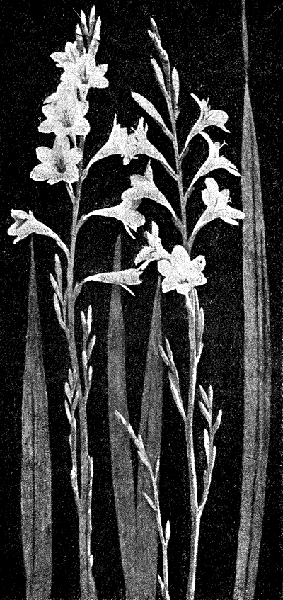
Rice. 187. Watsonia Alba
Witthemia (Veltheimia). Sem. Lileiny. A greenhouse bulbous plant with shiny wavy leaves, drooping tubular flowers, collected in a dense oblong spike up to 30-50 cm high. Blooms in winter. The dormant period is observed in summer when the plant sheds its leaves. With the resumption of growth (in September), transplants are made into fresh soil. Reproduction by children. The best species is V. capensis.
Hemantus (Haemanthus). Sem. Amaryllis. Valuable bulbous plant for indoor gardening. Flowers in dense capitate umbrellas on arrows, reaching 1 m in height. Propagated by seeds and children. In winter, it is at rest. In the spring, before the start of growth, a transplant is performed. In summer, Gemantus is displayed on balconies.
Hyacinth (Hyacinthus orientalis). Sem. Lileiny. One of the most beautiful bulbous plants of winter and early spring flowering. For the earliest distillation, there are Roman hyacinths - N. romanus hort with several flower arrows bearing only a small number of small white flowers. Already in late November - early December, this species can be in bloom.
The best early Dutch varieties blooming for the new year are: Homerus and Emilius with red flowers; L'Innocence with white flowers; Moreno with pink flowers; Charles Dickens, Pelisser and others. For later flowering, white ones are good - La grandesse, yellow ones - Mac-Magon.
The bulbs are stored in a cool, dry place before planting. For distillation, take only dense, heavy onions with an intact bottom. Terry varieties are distinguished by smaller bulbs.
Well-dried bulbs are planted up to their shoulders in 9-11 cm pots, matched to the size of the bulbs (Fig. 188). Roman hyacinths are planted in 13-centimeter pots, 3-5 pieces each. Pots with planted bulbs are installed in walls, basements, under racks, tightly to one another and covered with a layer of sand so that it covers the pots from above. A layer (20 cm) of dry, light, loose, sandy earth is piled onto a sandy shelter. The room temperature should not be higher than 4-6 ° C, since the bulbs take root only at a sufficiently low temperature.

Rice. 188. Planting geacinth bulbs (in the right pot - correct planting, in the left pot - wrong, too high)
Early forcing can also be prepared in the ground. In August-September, a ditch is dug with one bayonet and pots with planted bulbs are installed in it. The backfill is the same - with sand and sandy earth; before frosts, additional cover is given with a sheet or manure.
New pots are harmful for hyacinths, as the roots turn black in them, so you should always take pots that have already been in use. The land is sandy, not too greasy. After planting, the soil must be well shed with water.
When a flower arrow appears, the pots with plants are placed in the forcing compartment of the greenhouse, gradually increasing its temperature to 22 ° C, and for early varieties - to 26 and even 30 ° C. The readiness for the attachment is recognized by samples, taking out 1-2 plants. But this is done only when the plants cannot be left in place. The movement of plants is undesirable, since it is associated with the breakage of the roots that have passed through the drainage holes and with a change in the conditions for further cultivation. In order not to move the plants from their place, it is better to distill in a special greenhouse, gradually increasing its temperature to the required limit. With an untimely increase in temperature, only leaves grow in hyacinths, and the arrow does not develop. Late distillation is carried out at a lower temperature rise. For the strength of flowering and obtaining more compact sultans, it is necessary to lower the temperature to 10-12 ° C, when the flowers are already laid, but not yet colored. With this regime, the sultan will align with the leaves and even rise higher, and the flowers will fully develop.
Planting hyacinth bulbs in pots is done 3–3 1/2 months before the intended flowering period, in contrast to tulip, daffodil, and tacetus bulbs, which can be planted in 2 1/2 months.
Faded bulbs can be used next year for spring flowering in flower beds, or they are used for reproduction. The latter ripen in the 4th or 5th year, after which they become suitable for distillation. Seedlings also bloom no earlier than 4-5 years.
It was not possible to obtain results from local bulbs such as those given by the Dutch ones. Obviously, the more favorable conditions of the Dutch climate play a role here. By the way, from Holland, in order to get the best flowering, the bulbs are sometimes sent to ripen on the Mediterranean coast.
The faded bulbs are allowed to grow until June-July, until they shed the greens, after which they are removed from the pots and dried.
Hyacinth culture can be carried out in special glasses of water (Fig. 189). Only first-class bulbs are suitable for this forcing. Planting bulbs in glasses is done in October and earlier. The bottom of the bulb should not touch the water. The bulbs are covered with a paper cap and placed in a cool, dark place. When water evaporates, its supply in a glass must be replenished from time to time.Within two months, the bulb has time to develop roots and give a flower arrow, after which the plant is exposed to the light, where it blooms.
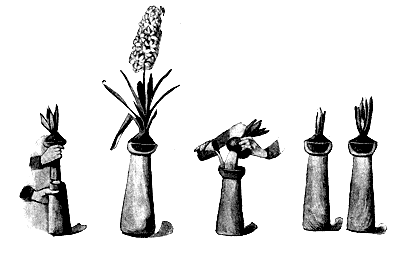
Rice. 189. Culture of hyacinths in glasses
Ixia (Ixia). Sem. Irisovs. A small bulbous plant. Bell-shaped flowers with a wheel-like limb. The bulbs are planted in the fall in pots of 10-15 pieces. In March, the plants are already in full bloom.
Krinum (Grinum). Sem. Amaryllis. Greenhouse and hothouse plant with a large bulb, turning into a herbaceous trunk. Flowers are collected by an umbrella on a juicy arrow. Blooms in summer.
Reproduction by children and seeds. When planting, the bulb is planted no more than 1/4 of its height. The transplant is performed in 2-3 years. Krinum requires spacious dishes; it is cultivated in tubs so that the thick, fleshy roots have enough room. When transplanting, the lump does not break, but the old soil can be slightly separated with a peg. The land is a mixture of leaf, turf and sand.
More than 100 species of krinum are known. The best greenhouse species: S. amobile with fragrant white flowers and a pink tube. C. Kunthianum with fragrant white flowers and red stripes on the petals. C. Kirkii with multiple arrows from a single bulb and C. latifolium.
The best greenhouse ones are: C. Moorei with a beautiful crown of leaves and pale pink, fragrant flowers; C. scabrum with white flowers with pink stripes; C. Sanderianum with white flowers in crimson stripes: C. capense, C. fimbriatum, and C. erubescens.
The Powellii hybrid with abundant white flowers is an excellent crop for cutting. Its varieties: album, intermedium. C. Laurentii is no less beautiful, blooming profusely from July to frost. In the south, both species can be cultivated outdoors. There is no doubt that the Powellii and Laurentii species should gain industrial importance for both potting and cutting.
Crocus (Crocus). Saffron Sem. Irisovs. Planting 4-6 bulbs in 10-centimeter pots is done for early flowering in August, for later flowering in September.
The pots are kept dug in (covering them with a layer of earth up to 10 cm) from 4 to 6 decades, until the tops of the leaves appear, after which the pots with plants are placed in a bright cool greenhouse with a temperature of 6-8 ° C, watering moderately. Light and low temperatures promote good flowering. Faded corms are suitable for soil culture for the next year.
Lachenalia (Lachenalia). A beautiful bulbous plant with flowers of golden yellow, purple and violet in various shades. Blooms in March-April. With early distillation, Lachenalia can be in bloom as early as December. Planting of several pieces in pots, baskets and ampli is done in August. Lachenalia is especially good in amples.
Lilies (Lilium). Sem. Lileiny. A wide variety of species and varieties of lilies allows, by selection, to have these plants in bloom almost all year round. For forcing lilies, the bulbs are taken from the ground. They are planted in fairly spacious pots in autumn and winter for spring flowering, or in spring (March-April) for summer flowering (mainly L. auratum).
Depending on the type and variety, forcing lilies takes from 8 to 13 decades. The land is clay-turf with an admixture of completely rotted humus and coarse sand.
Lilies need high pots up to 15 cm in diameter. Pots with bulbs are covered by one third or half, so that as the stem grows, its base can be added and covered with earth in those species of lilies that form stem roots. The earth is gradually poured almost to the edges of the pot, leaving only a place for watering.
At first, the bulbs are kept at a temperature of no more than 10-12 ° C, and only with the appearance of buds for their better development, the temperature is raised to 20 ° C. To lengthen the flowering period of lilies, the temperature can be lowered to 5-7 ° C.
The best species for winter forcing are Japanese lilies (L. speciosum) and mainly varieties such as rubrum, Melpomene, roseum, punetatum, album, Kratzeri and rnagnificum.
For flowering in April, L.longifolium with varieties: L. I. eximium, L. Harrisi, Forrnosum. Lilies are also good - L. auratum.
Winter-flowering lilies can be obtained from "ice" bulbs, that is, those stored in glaciers or in basements with artificial cooling. These bulbs are planted in pots in June-July and placed in low-temperature basements for rooting. At the time of rooting, in general, all bulbs need a low temperature. Only with the appearance of sprouts are plants transferred to a cool greenhouse. It takes 3-4 months from planting the bulbs in pots to flowering.
Bulbs of L. regale are predominantly used for potting. This lily can be cultivated in pots for several years in a row and does not last longer than other lilies. L. regale gives good results when distilled at 25 ° C.
The lily culture is most developed in Japan.
Narcissus (Narcissus). Sem. Amaryllis. The culture is carried out simultaneously with hyacinths under the same conditions. The maximum temperature should not be higher than 15 ° C. Most varieties of daffodils are added in early January, and varieties such as N. poeticus ornatus (white) and Van Sion (yellow) bloom by the new year. The same conditions for adding tazets and jonquils.
Pancratium (Fig. 190). Sem. Amaryllis. Greenhouse evergreen with lanceolate elliptical leaves. Graceful tubular flowers with a funnel-shaped limb are collected by an umbrella. The scent of the flowers is reminiscent of vanilla.
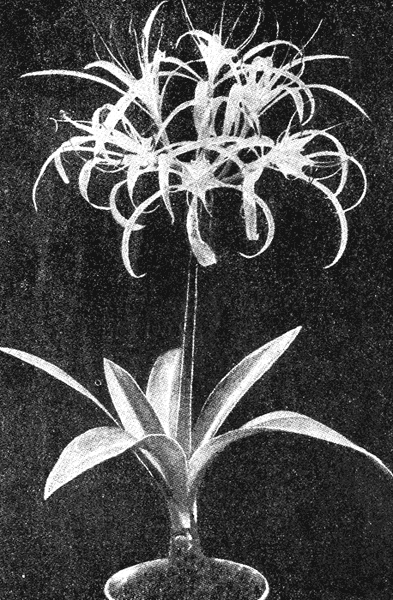
Rice. 190. Pancratium specialozum
Planting in October in a cold greenhouse. Weak watering. When the plant starts growing, it is transferred to a moderately warm, well-ventilated greenhouse.
During the growing season, abundant watering is given. The earth is nutritious, loose. When planting, only the top of the bulb remains uncovered. Blooms in April-May in a warm-humid regime. After flowering, watering is reduced, and by August-September it stops. Propagated by children separated during transplantation. The best species are P. Illiricum, P. maritimum, P. canariense and P. speciosum.
Tigridia (Tigridia). Sem. Irisovs. Greenhouse plant with scaly bulbs, xiphoid folded-furrowed leaves and large, very beautiful flowers. In the south, as well as in the middle regions (under cover), it overwinters in the open field. Blooms in July. After flowering until autumn, they are kept without watering, and in winter they are stored in dry sand. Propagated by children and sowing. The best view is T. Pavonia with varieties.
Tuberose (Polyanthes tuberosa). Sem. Amaryllis. A wonderful plant with oblong, bulbous tubers. Graceful white tuberose flowers in the form of funnels with a six-lobed limb have a strong pleasant smell.
Suitable for potting. Suitable for flower arrangements - bouquets and planting in flower baskets.
For flowering in September, tubers are planted in pots in May, in a mixture of leaf, turf and greenhouse land with sand. It is better to keep a hot greenhouse in the stale air in full sun, without any shade. Only with the onset of warm weather, the plants are accustomed to the air, and later the frames are completely removed.
For flowering in November, they are planted later. It takes 4 months from planting to flowering. Faded tubers are stored in a dry and cool place. There is a terry variety of The Pearl.
Tulip (Tulipa). Sem. Lileiny. Among the bulbs for forcing, tulips rank first after hyacinths. Forcing tulips is done in the same way as hyacinths. Planting of bulbs begins in August and can continue through October. The earliest tulips can be blooming in December. Three bulbs are usually planted in a pot.
Early varieties are known: D. V. Thol (different colors), Proserpine (carmine pink), Mon Tresor (yellow), Rembrandt (scarlet), Le Matelas (pink), Pettebacker (white).
For flowering after the new year - Vermilion brilliant; Murillo - terry (pink)
Just like hyacinths, tulips can also be bloomed in indoor culture.
In January-February, tulips in a temperate greenhouse, although slowly, develop without forcing and come out incomparably better than with early forcing.
Freesia (Freesia refracta alba). Cape lily of the valley. Sem. Lileiny. Freesia flowers smell like a lily of the valley. For continuous flowering, sowing of freesia is done after 1-2 decades; it takes about six months from sowing to flowering. Flowering lasts about 15 days.
Seedlings, cut into boxes, are placed in a greenhouse, and in the summer - on open beds. Fertilizing watering is given to the plants. In the fall, the boxes are transferred to a cold greenhouse with a temperature of 5-7 ° C; after the buds appear, the temperature is raised to 10-12 ° C. Freesias have small tubers, which are planted in 5 (and more) pieces in 11-12-centimeter pots.
The best varieties are F. hybrida Tubergenii and F. h. Ragionieri, namely Robinetta, Golden Wander, Albignone, Opal and Orchideae.
Eucharis (Eucharis amasonica). Sem. Amaryllis. A greenhouse plant with beautiful, snow-white, fragrant flowers. The first bloom from October to deep winter; blooms for the second time in May. A greater effect can be obtained by cultivation in the soil of a greenhouse with a subsoil heat of 12-15 ° C. From the soil, eucharises are transplanted into pots. Planting is done in groups (families). In March and August, the plant is in relative dormancy, so watering at this time almost stops.
During the dormant period, a transplant is made with an earthen lump. A transplant is required in 3-4 years. Unlike other bulbous plants, it is not recommended to separate the children during transplantation of eucharis, since eucharises planted alone almost never bloom. The land is given the most nutritious. In winter, the plants are kept at 13-15 ° C, to accelerate flowering, the temperature is increased by 5-8 ° C and more light is given.
Epiphytes
Epiphytes include a group of plants that inhabit the trunks, branches and leaves of other plants. Epiphytes do not bring direct harm to the latter, since they have independent nutrition - in contrast to parasites. Orchids, bromeliads, gesneria and some other plant families are rich in epiphytes.
Bromeliad plants (Bromeliaceae). Greenhouse plants, mostly epiphytic, with beautiful, leathery, xiphoid, often variegated leaves in a rosette. They have graceful, sessile flowers in spikelets with bright bracts. The best plants for indoor gardening.
The culture of bromeliads is not difficult, as they are rather undemanding plants. The land is given to them from a mixture of turf, peat, leaf and sand. In the summer, watering and abundant spraying.
Propagated by offspring and seeds; the latter are obtained by artificial cross-pollination. The transplant is performed in 2-3 years. Need fertilizing watering. Small bromeliads are grown like orchids - on stumps, pieces of bark, etc., and larger ones - in cups or bowls in a mixture of peat and semi-rotten leaf earth, charcoal and sand. Bromeliad plants, which are highly adaptable, should be widely used for indoor gardening.
Orchids (Orchideae). Perennial herbaceous plants of hot tropical and temperate countries. Orchids have simple, whole-edged, petiolate leaves on more or less thick, straight, clinging or bulbous stems at the base. Flowers are solitary, racemose, paniculate and spike-like. The corolla of a flower consists of three inner (upper) and three outer (lower) petals arranged in two circles. One of the inner petals, called the lip, is more developed than the others; it is painted in a wide variety of colors and often resembles insects, shells, a human figure, etc. in its bizarre shape. Three flower stamens are attached to the column, only one or two of them are developed. The fruit is a unilocular capsule with extremely small dusty seeds.
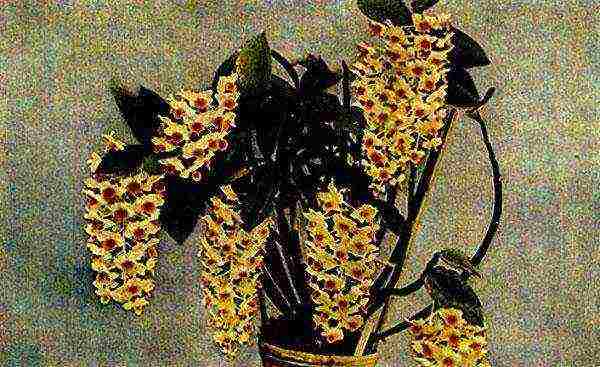
Orchid "Dendrobium" (Dendrobium thysi florum)
Orchids are divided into two main groups: 1) terrestrial with rhizomes and tubers, 2) epiphytic with aerial roots.
Ground or ground orchids rooted in the ground are cultivated in pots and bowls with compost consisting of a mixture of peat soil, semi-rotten foliage, clay, humus, pieces of coal and sand.
Epiphytic orchids are attached by aerial roots to cork planks, to pieces of wood with bark, to wooden, sometimes charred chocks, or are grown in wooden perforated bowls and baskets of wooden sticks tied with wire. The pots and baskets are filled with fern soil (from under the fern growing in the open field - polypodium) and the fibrous roots of this fern. Orchid roots are lightly wrapped in moss and tied to a piece of wood with soft wire.
Orchids reproduce by division, cuttings, seeds and bulbs.
Various methods of division are practiced: the separation of individual stems of the bush with roots (dendrobium), reproduction by cut off old cones of faded orchids (oncidium, fayus, rejoice, etc.), cutting off the stem and, finally, the separation of young plants formed on old cones (epidendrum).
The cuttings are old, pineal, elongated stems (tunia), side shoots (vanilla), faded flower stems (phalaenopsis).
Propagation by seeds obtained as a result of cross-pollination is carried out to develop new varieties. The seeds are sown in a mixture of chopped moss with fine peat and pieces of old orchid roots. Seeds quickly lose their germination, so sowing should be done as soon as the seeds are ripe. Crops must be supplied with moisture from the bottom. For seed germination, a temperature of 20-25 ° C is required. Fortified seedlings are split into a mixture composed of equal parts of chopped moss, fibrous peat and deciduous soil. Orchids derived from seeds bloom in the fourth year, and sometimes even later.
Some orchids (cellogyne) are propagated by bulbs - small baby cones that form on old stem cones.
With mass culture, orchids must be grown in special greenhouses adapted to the culture of certain species of these plants, since orchid culture in ordinary greenhouses does not give good results.
The temperature of orchid greenhouses ranges from 10, 16, 20 ° C, depending on the natural growing conditions of cultivated species. Air humidity is a necessary condition for the normal development of plants. In the summer, orchids need not only watering, but also daily spraying of the greenhouse to humidify the air. Instead of watering, pots or pieces of wood containing orchids can be submerged in water at a temperature slightly higher than the ambient temperature. Some orchids growing in the shade at home should be watered abundantly. In winter, during the dormant period, the plants are kept drier.
Transplantation of terrestrial orchids is carried out after 2-3 years, epiphytic ones - after 4-6 years. Transplant time is February-March.
Orchids respond well to nitrogenous fertilization in the form of crushed horn shavings, dried and crushed cow dung, and liquid fertilizer. But the excess of these fertilizers can lead to the death of plants.
The orchid greenhouse must be kept clean and well ventilated. Against pests - snails, wood lice and aphids - control measures must be taken in a timely manner.
Orchid greenhouses have a number of features. They use, for example, a device for the entire length of the room of cement basins to humidify the air. When growing the most moisture-demanding orchids, they arrange racks with water inlet and outlet. Plants are placed on racks on pots overturned in water.
In orchid greenhouses, laying heating pipes on top is completely unacceptable, since such a laying system greatly dries up the air.
Orchids require a lot of fresh air. To improve the ventilation of the greenhouse, a special cover is arranged along the entire length of the ridge, which rises as needed, and the greenhouse is well ventilated. For the same purpose, ventilation hatches are made in the side walls of the greenhouse.
To avoid unnecessary heating of orchids that require summer shading, shade devices are arranged at some distance from the glass surface of the greenhouse roof.
Moving on to cultural issues, it must be said that the composition of the soil for orchids does not play such a big role as it was given by cultivators in the past. Leafy soil, which used to be a must in the composition of the soil mixture for orchids, was often the cause of their death. German cultivators recommend a mixture that includes the roots of osmund and polypodium ferns, sphagnum (marsh moss, which contains a lot of moisture) and half-rotted crushed beech or oak leaves.
For epiphytic orchids "cattley", "vanda", "lelia" "phalaenopsis" and others, take 2 parts of osmund roots, 1 part of polypodium roots, 1 part of beech leaves and 1 part of sphagnum. For other epiphytes (odontoglossum, oncidium, dendrobium, miltonia, etc.), the mixture is made up of 1 part of the roots of osmund, polypodium, sphagnum and 2 parts of beech leaves. Earth orchids — fayus, cypripedium, etc. — are grown in a mixture of 3 parts of beech leaves, 1 part of sphagnum, with a small addition of clay and coarse grained sand.
The best crockery for orchids is pots with good drainage from broken shards. Deep landing is a mistake of the old technique; orchids should be planted on a mound. Orchid replanting is required when the soil becomes acidic or depleted. Plants are best replanted when young shoots appear. For most orchids, this happens in February-April.
Some orchids are distinguished by almost continuous flowering, for example, cypripedium (C. calurum), odontoglossum (O. crispum), oncidium (O. papilio majus), etc.
Of the more common genera of orchids, the following should be noted:
Vanda. Beautiful evergreen epiphytic orchids with blue fragrant flowers in clusters. Grow well in partial shade. The best varieties are V. coerulea, V. tricolor, etc.
Dendrobium (Dendrobium). Epiphytic orchid; for its winter culture does not require a temperature higher than 12-15 ° C. Flowers with a flattened lip. The best species are D. nobile, D. superbum and D. Wardianum.
Cattleya (Gattleya) is a fairly hardy epiphytic orchid, grown at 10-12 ° C. A sunny place and good air exchange are required. Best species: C. citrina and C. labiata.
Lelia (Laelia). Epiphytic orchid, with permanent leathery, thick leaves and large red flowers, collected in ears. Kept at a temperature of about 15 ° C. Requires a sunny location and good air exchange. The best species: L. purpurata, L. Perrinii, L. autumnalis, L. anceps.
Lycaste. One of the most beautiful epiphytic orchids with pure white or bright pink flowers. Best species: L. SkinnenT L. aromatica.
Miltonia (Miltonia). Greenhouse epiphytic orchid. Contained at a temperature of 15–20 ° C. Flower arrows grow at the base of new bulbs. Best species: M. Candida, M. Roezlii, M. phalaenopsis,
Odontoglossum (Odontoglossum). Epiphytic orchid, grown in cool, clean air. The base of the lingual lip of the flowers has four processes. The best species: O. crispum, O. grander O. Pescatorei, O. gloriosum, etc.
Oncidium (Oncidium). Greenhouse and greenhouse epiphytic orchid, with evergreen leaves. The best species: O. incurvum, O. varicosum, Rogersii, 0. splendidum, 0. crispum, etc.
Fayus (Phajus). Greenhouse earthen orchid, kept at a temperature of 20-25 ° C. Large open flowers with a prominent lip; the edges of the flower are rolled into a tube and elongated with a wavy cone. Best View: P. grandifolius.
Phalaenopsis (Phalaenopsis). Very beautiful greenhouse, epiphytic orchid. Flowers in brushes. Long bloom. Best views: Ph. amabilis, Ph. gloriosa. Variety: Rimstaedtiana.
Cypripedium. The lady's slipper is an earthy orchid. Its tropical species are kept at 15-20 ° C, and more hardy ones - at 8-12 ° C. Flowers with a swollen shoe-like lip. There are wintering species that are cultivated in deep loose soil in semi-shady rock gardens. Cypripedium can be successfully grown together with asparagus in a greenhouse - this is the simplest orchid in culture. The best species are C. insigne, G. villosum, C. barbatum, C. Harrysianum and C. seanum.
Cygopetalum (Zygopetalum). Epiphytic orchid with leathery xiphoid leaves, throws out an arrow with 4-8 flowers. Best species: Z. crinitum and Z. Mackayi.
In the middle zone of the Union, three types of orchids grow in the open air, which deserve the attention of cultivators:
1. Near Moscow orchis - "Night violet" (Satyrium bifolium). A fragrant plant with a subtle and delicate scent, its bouquets are in no less demand than lilies of the valley.
2. Lady's slipper (Cypripedium guttatum). Flowers of a beautiful structure, but no smell. In the Moscow region, it grows mainly in the area of the Lenin Hills.
3. Spotted orchis - "Cuckoo's tears" (Orchis maculata). A plant with purple flowers, but also odorless.
In addition to bromeliads and orchids, we note from epiphytic plants:
Eshinanthus (Aeschynanthus). Sem.Gesnerievs. Greenhouse epiphytic shrub, grown mainly in hanging vases and baskets in the ground with an admixture of chopped moss. It has succulent stems, curved tubular flowers with an irregular obtuse limb. Propagated by cuttings with leaves. Moisture and shade required. Best views: Aesch. Lamponga and pulcher.
A 7-letter word, the first letter is "P", the second letter is "A", the third letter is "C", the fourth letter is "C", the fifth letter is "A", the sixth letter is "D", the seventh letter is "A", a word with the letter "P", the last "A". If you do not know a word from a crossword or scanword, then our site will help you find the most difficult and unfamiliar words.
SEEDLING Suitable Not suitable
Other meanings of this word:
- Rose from seed
- Grows from seeds
- Planted in spring
- More "green" plants
- Young growth on the window in spring
- Young in the garden
- Young plants
- Young plants for transplanting
- Young plants grown in greenhouses
- Young plants grown in greenhouses for subsequent transplantation (on ridges, plots, in the field)
- Young plants grown in a greenhouse for transplanting into open ground
- Young plants intended for planting in open ground
- Young sprouts
- Garden young
- Toddler cucumbers
- Greenhouse fry
- Shoots in boxes for the future. beds
- Plant to be planted
- Sprouts on the ground
- Nursery product
- An emigrant from a windowsill to a summer cottage
- Yuntsyogurtsy
Growing chard on video.
Despite the fact that Swiss chard is a subspecies of beet, it is grown in private plots for the sake of obtaining greens. It is much softer than the tops of true beets, and therefore it is successfully used to prepare fresh salads and other vitamin dishes with high nutritional value. For growing Swiss chard, it is best to use sheltered film covers.
Mangold is a valuable biennial plant, lettuce and spinach, but, unfortunately, is rarely cultivated. This, by the way, is the most ancient variety of beets - the predecessor of the canteen. The ancient Romans called it Roman cabbage and used it by soaking the leaves in wine and pepper.
Chard forms a small woody root vegetable and a rosette of large vesicular leaves with fleshy petioles. In a rosette, Swiss chard has unsurpassed nutritional value due to its unique chemical composition, which has a beneficial effect on the human body.
The biochemical composition of chard leaves is close to spinach, but they have a slightly higher protein content and no oxalic acid. And in terms of carotene content, chard is close to carrots. The mineral composition of chard is also rich, especially a lot of potassium and calcium.
Leaves and petioles are eaten. Swiss chard leaves taste like spinach. Some hobbyists have completely replaced spinach with chard in their gardens.
The special value of this culture is its early maturity and resistance to shooting. Marketable products when growing chard in greenhouses can be harvested within 25-40 days after germination.
How to plant chard for forcing greens
As practice shows, it is possible to plant Swiss chard for distilling greens from root crops harvested in the fall in any structure, even storage facilities. Root crops are planted in boxes, on the beds in November-December. Plants are placed in boxes in a bridge way, covered with soil, leaving the apical bud open. During the first 10-12 days, the boxes can be kept in stacks, then they are placed in one row, in free spaces, under the shelves. They grow Swiss chard even without access to light. Under such conditions, the so-called asparagus products are obtained from the stalks and poorly developed bleached leaves. In the beds in greenhouses, in greenhouses, root crops are also placed in a bridge way, leaving paths for passage. Consumption of planting material - 4-8 kg / m2.After planting, watered abundantly, then watered periodically at lower rates. In a period of insufficient illumination, the irrigation rate for growing leaf beets is less than chard. At the beginning of distillation, the temperature is maintained within 10-12 ° C; when the first leaf appears, it is better to raise it to 14-18 ° C. Care is normal, like forcing. After 30-40 days, the herbs begin to be harvested selectively.

As practice shows, chard can be grown in greenhouses, in film greenhouses by sowing seeds in August - early September, when the greenhouses are vacated after harvesting the main crop. The seeding rate is 10 g / m2, the feeding area is 20 x 20 or 25 x 25 cm. In the first period, special attention is paid to watering. In the future, at the end of October - November, you can cover the greenhouse with a film, and for additional insulation - put temporary shelters over the beds. When caring for chard in greenhouses, it is recommended to use emergency heating. It is considered irrational to cover greenhouses with foil before winter. However, there is evidence that during winter operation the weather resistance of the polyethylene film increases and it is less damaged in the spring-summer period. The harvest is collected selectively until the end of December, it is 2-8 kg per 1 m2.
How to grow chard in a greenhouse
Mangold is a cold-resistant plant, seedlings are damaged by frosts only at a temperature of 3 ... -4 ° С, adult leaves withstand short-term frosts up to -5 ... -6 ° С, and dug up roots are damaged at -2 ° С. Chard winters well in the garden. Beetroot is a heat-resistant plant, but requires good moisture to obtain high yields. When leaving during the cultivation of chard, the plants need good lighting; it is unacceptable to grow it under the cover of other crops. To obtain a high yield of leaf beets, they are given a sunny place and fertile soil.
Mangold is the most grateful crop for growing in greenhouses. For 2-3 cuts, you can get up to 8 kg of valuable leaves and petioles.
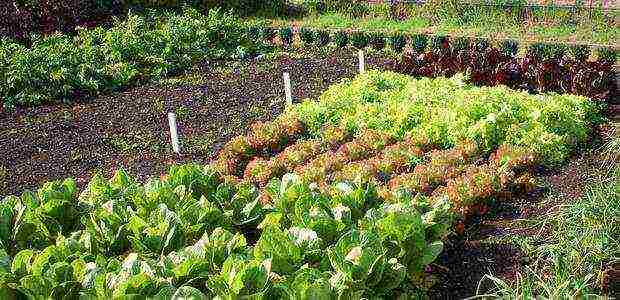
You can leave the greenhouse or greenhouse with young plants open during the winter. In this case, the plants should be well covered with mulch. In the case of growing chard in a closed greenhouse in late January - early March, the harvest is obtained until mid - late April, until the planting of cucumber and tomato seedlings.
Chard leaves are harvested on the day of use. From spring sowing, they can be cut several times from one plant during the growing season, as they grow back quickly. Attention should be paid to timely harvesting from autumn crops, since overwintered plants, after the formation of a rosette, quickly give a flowering shoot. With proper planting and caring for chard, the yield of leaves is about 30 petioles (10 kg per 1 m2).
Chard leaves have a more delicate texture than beetroot. They are used fresh, in salads and for juice, as well as for preparing first and second courses. Petioles are most often prepared as cauliflower, asparagus, with various sauces, added to omelets. You can replace cabbage with them in borscht and harvest it for future use - freeze it.
